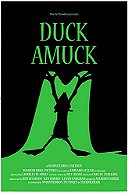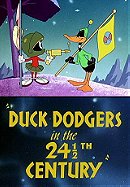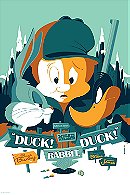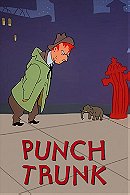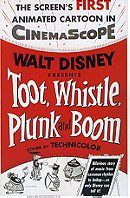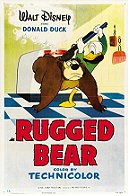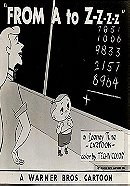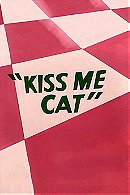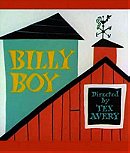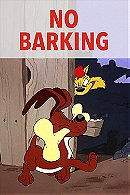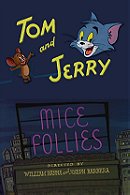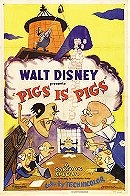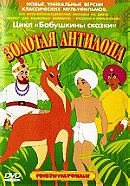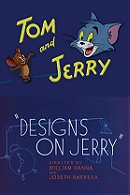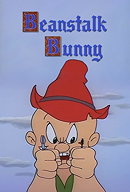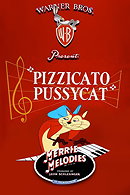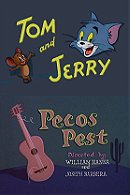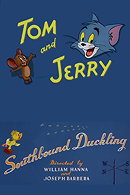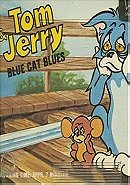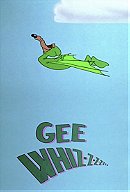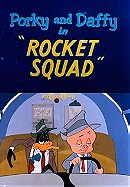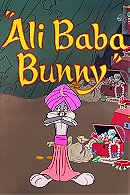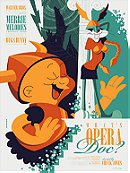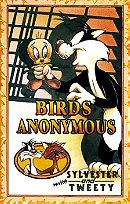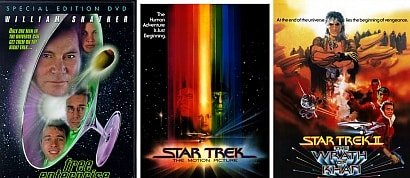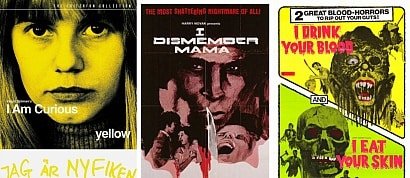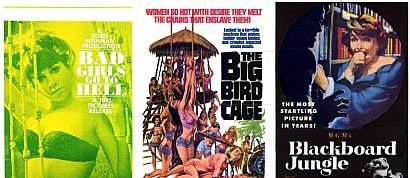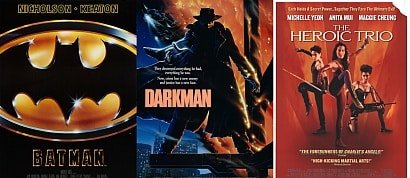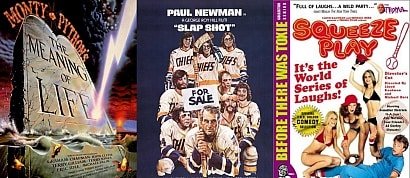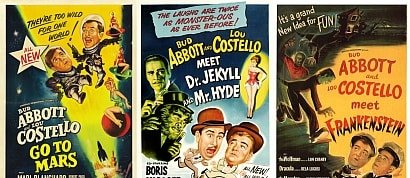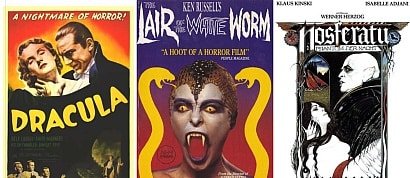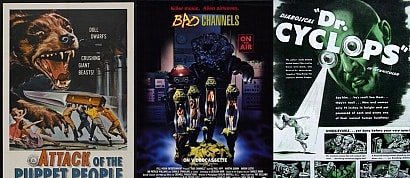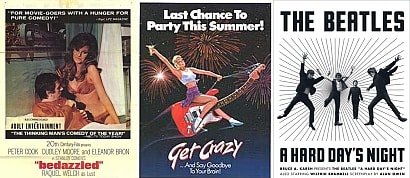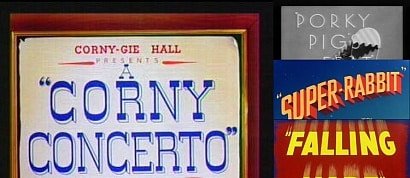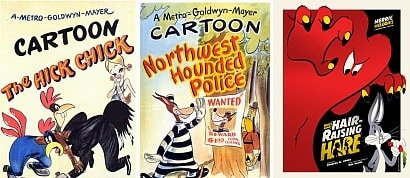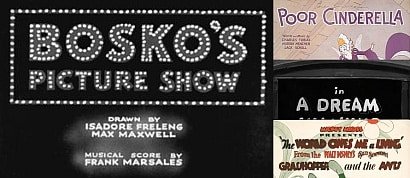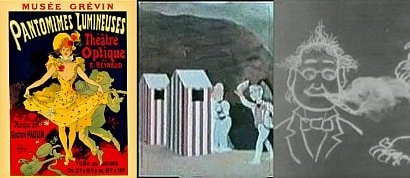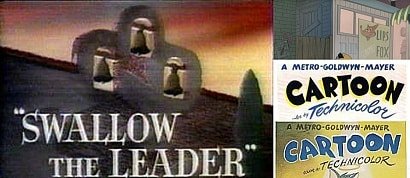1001 Animated Shorts You Must See - Part 7
Sort by:
Showing 50 items
Decade:
Rating:
List Type:
Don't Give Up the Sheep (1953)
DIR: Chuck Jones
SUMMARY: A scraggly wolf makes various attempts to steal sheep out from under the nose of a brawny, ever-watchful sheepdog.
WHY IT'S HERE: Chuck Jones's 'Don't Give Up the Sheep' is the first of six cartoons Jones made with the lesser known characters of Sam Sheepdog and Ralph Wolf (although in this early entry to the series it is the Sheepdog who is called Ralph and the Wolf is unnamed). The first thing cartoon buffs will notice is that, but for his red nose, the Wolf is basically Wile E Coyote. What provoked this design decision is uncertain and it may have just been down to laziness but Jones later turned it into a brilliant comment on both the similarity and difference between the Sheepdog and Wolf shorts and the Road Runner series. The Wolf's attempts to capture the sheep in a series of blackout gags could and have been likened to the style of storytelling in the Road Runner cartoons but there's a key difference that tells us that Ralph Wolf is completely different from Wile E Coyote. The Coyote is an insanely obsessive creature driven by his one track mind to catch and devour the Road Runner. The highly unusual opening scenes of the Sheepdog and Wolf cartoons, however, reveal that Ralph is simply fulfilling his duties as he punches in on a timecard like any other workaday stiff. His duties are presumably determined by either nature or the all powerful cartoonists. The fact that only the Sheepdog punches in at the beginning of 'Don't Give Up the Sheep' suggests that maybe Jones extension of this gag to the Wolf as well may have been a sly joke at the expense of those who accused him of repeating himself.
In my opinion, those who claim that the Sheepdog and Wolf cartoons are just a retread of Road Runner are absolutely wrong. This is a quite different setup in which the antagonist has the added inconvenience of having to remain covert. The brutal, threatening presence of Sam the Sheepdog is a quite different proposition from the falling boulders and malfunctioning gadgets that scupper Wile E Coyote's plans. The implication here is that Ralph is extremely good at catching sheep and would undoubtedly be a success were Sam just not that tiny bit better at his job. Ralph is not the self-sabotaging dupe that the Coyote is, he's merely the victim of a superior co-worker.
All of which tells you nothing specific about 'Don't Give Up the Sheep', for which I apologise. To finally set aside all the prevarication, 'Don't Give Up the Sheep' is a superb cartoon. The jokes, courtesy of Michael Maltese, are brilliantly inventive and unpredictable. The funniest gags are often the simplest, such as the panpipe sequence or the wildcat joke. There's also a hilarious extended piece involving the sawing of branches which leads up to the only already well-used punchline in the cartoon. I always enjoyed the later episodes in which the Wolf punched in alongside the Sheepdog and it was implied that they were casual friends outside the working hours of a job that demanded they be enemies but 'Don't Give Up the Sheep' makes up for this omission by sheer quality of the gags and their impeccable execution.
SUMMARY: A scraggly wolf makes various attempts to steal sheep out from under the nose of a brawny, ever-watchful sheepdog.
WHY IT'S HERE: Chuck Jones's 'Don't Give Up the Sheep' is the first of six cartoons Jones made with the lesser known characters of Sam Sheepdog and Ralph Wolf (although in this early entry to the series it is the Sheepdog who is called Ralph and the Wolf is unnamed). The first thing cartoon buffs will notice is that, but for his red nose, the Wolf is basically Wile E Coyote. What provoked this design decision is uncertain and it may have just been down to laziness but Jones later turned it into a brilliant comment on both the similarity and difference between the Sheepdog and Wolf shorts and the Road Runner series. The Wolf's attempts to capture the sheep in a series of blackout gags could and have been likened to the style of storytelling in the Road Runner cartoons but there's a key difference that tells us that Ralph Wolf is completely different from Wile E Coyote. The Coyote is an insanely obsessive creature driven by his one track mind to catch and devour the Road Runner. The highly unusual opening scenes of the Sheepdog and Wolf cartoons, however, reveal that Ralph is simply fulfilling his duties as he punches in on a timecard like any other workaday stiff. His duties are presumably determined by either nature or the all powerful cartoonists. The fact that only the Sheepdog punches in at the beginning of 'Don't Give Up the Sheep' suggests that maybe Jones extension of this gag to the Wolf as well may have been a sly joke at the expense of those who accused him of repeating himself.
In my opinion, those who claim that the Sheepdog and Wolf cartoons are just a retread of Road Runner are absolutely wrong. This is a quite different setup in which the antagonist has the added inconvenience of having to remain covert. The brutal, threatening presence of Sam the Sheepdog is a quite different proposition from the falling boulders and malfunctioning gadgets that scupper Wile E Coyote's plans. The implication here is that Ralph is extremely good at catching sheep and would undoubtedly be a success were Sam just not that tiny bit better at his job. Ralph is not the self-sabotaging dupe that the Coyote is, he's merely the victim of a superior co-worker.
All of which tells you nothing specific about 'Don't Give Up the Sheep', for which I apologise. To finally set aside all the prevarication, 'Don't Give Up the Sheep' is a superb cartoon. The jokes, courtesy of Michael Maltese, are brilliantly inventive and unpredictable. The funniest gags are often the simplest, such as the panpipe sequence or the wildcat joke. There's also a hilarious extended piece involving the sawing of branches which leads up to the only already well-used punchline in the cartoon. I always enjoyed the later episodes in which the Wolf punched in alongside the Sheepdog and it was implied that they were casual friends outside the working hours of a job that demanded they be enemies but 'Don't Give Up the Sheep' makes up for this omission by sheer quality of the gags and their impeccable execution.
Much Ado About Nutting (1953)
DIR: Chuck Jones
SUMMARY: A determined squirrel goes to excessive lengths in the attempt to open a seemingly impenetrable coconut.
WHY IT'S HERE: Chuck Jones's 'Much Ado About Nutting' is a calculated, slow-paced cartoon which ultimately suffers from a weak and overly bizarre punch line. Nevertheless, Jones's genius is amply displayed in the lead-up to this disappointing finale. The squirrel is rendered in a more realistic style than the anthropomorphised creatures that populate most cartoons and the story is played out sans dialogue. Jones uses this to his advantage, highlighting the squirrel's growing frustration and obsession for laughs. Indeed, 'Much Ado About Nutting' is at its funniest and most impressive between the punchlines. For instance, the gag at the end of the Empire State sequence is amusing enough but the lead up to it, in which we watch the squirrel agonisingly push the coconut up the thousands of stairs is extraordinarily attractive and tinged with both a sense of suspense and not a little inevitability. 'Much Ado About Nutting' does not quite scale the heights of the truly classic Warner one-shots but it is constantly engaging and occasionally wonderful.
SUMMARY: A determined squirrel goes to excessive lengths in the attempt to open a seemingly impenetrable coconut.
WHY IT'S HERE: Chuck Jones's 'Much Ado About Nutting' is a calculated, slow-paced cartoon which ultimately suffers from a weak and overly bizarre punch line. Nevertheless, Jones's genius is amply displayed in the lead-up to this disappointing finale. The squirrel is rendered in a more realistic style than the anthropomorphised creatures that populate most cartoons and the story is played out sans dialogue. Jones uses this to his advantage, highlighting the squirrel's growing frustration and obsession for laughs. Indeed, 'Much Ado About Nutting' is at its funniest and most impressive between the punchlines. For instance, the gag at the end of the Empire State sequence is amusing enough but the lead up to it, in which we watch the squirrel agonisingly push the coconut up the thousands of stairs is extraordinarily attractive and tinged with both a sense of suspense and not a little inevitability. 'Much Ado About Nutting' does not quite scale the heights of the truly classic Warner one-shots but it is constantly engaging and occasionally wonderful.
DIR: Chuck Jones
SUMMARY: Daffy Duck finds himself being manipulated by an unseen animator in this classic of animation.
WHY IT'S HERE: Where to begin with 'Duck Amuck'? I guess I should begin by stating that not only is Daffy Duck my favourite cartoon character of all time but that I genuinely consider him to be one of the greatest comedians of all time, alive or animated. No matter which animator was drawing him, scriptwriter was writing for him or director was directing him, Daffy always elicits a positive reaction from me whether the cartoon in question is decent or not. In the case of 'Duck Amuck', "decent" is the understatement of the century! It's a miraculous achievement which I never tire of seeing.
In 'Duck Amuck', Daffy battles with an unseen animator who deconstructs the film around him. Pencils, brushes and erasers intrude on Daffy's world, changing the scenery and even the appearance of Daffy himself and Jones also introduces jokes involving sound, colour and camera positions. It's an incredible premise which expands on earlier experiments with similar concepts like the Fleischer Brother's 'Out of the Inkwell'. The best part for Daffy fans like myself is that 'Duck Amuck (until its final few seconds) is an entirely one-personality cartoon. It hinges on Daffy's beautifully scripted monologue which makes the most of the characters distinctive turn of phrase and manic energy. Only Daffy could pull off a solo cartoon like this (as confirmed by 'Rabbit Rampage', an unsuccessful attempt to remake 'Duck Amuck' with Bugs Bunny in the central role). There's plenty to please fans of most Daffy personas here. Although the greedy and selfish side of the little black duck is absent (making him all the more likable and therefore rendering the cartoon even more deliciously sadistic), his prominent ego is apparent from the opening frame and the manic energy of his early incarnation is quickly drawn upon as he becomes more and more frantic about the crumbling of his world. It's a true tour de force.
I don't think I have ever come across anyone who has a bad word to say about 'Duck Amuck'. It is quite simply one of the most perfect cartoons ever made, perhaps the most perfect. It's confirmation, if any was needed, of the genius of Chuck Jones and the comedic superiority of Daffy Duck over any of his animated associates.
SUMMARY: Daffy Duck finds himself being manipulated by an unseen animator in this classic of animation.
WHY IT'S HERE: Where to begin with 'Duck Amuck'? I guess I should begin by stating that not only is Daffy Duck my favourite cartoon character of all time but that I genuinely consider him to be one of the greatest comedians of all time, alive or animated. No matter which animator was drawing him, scriptwriter was writing for him or director was directing him, Daffy always elicits a positive reaction from me whether the cartoon in question is decent or not. In the case of 'Duck Amuck', "decent" is the understatement of the century! It's a miraculous achievement which I never tire of seeing.
In 'Duck Amuck', Daffy battles with an unseen animator who deconstructs the film around him. Pencils, brushes and erasers intrude on Daffy's world, changing the scenery and even the appearance of Daffy himself and Jones also introduces jokes involving sound, colour and camera positions. It's an incredible premise which expands on earlier experiments with similar concepts like the Fleischer Brother's 'Out of the Inkwell'. The best part for Daffy fans like myself is that 'Duck Amuck (until its final few seconds) is an entirely one-personality cartoon. It hinges on Daffy's beautifully scripted monologue which makes the most of the characters distinctive turn of phrase and manic energy. Only Daffy could pull off a solo cartoon like this (as confirmed by 'Rabbit Rampage', an unsuccessful attempt to remake 'Duck Amuck' with Bugs Bunny in the central role). There's plenty to please fans of most Daffy personas here. Although the greedy and selfish side of the little black duck is absent (making him all the more likable and therefore rendering the cartoon even more deliciously sadistic), his prominent ego is apparent from the opening frame and the manic energy of his early incarnation is quickly drawn upon as he becomes more and more frantic about the crumbling of his world. It's a true tour de force.
I don't think I have ever come across anyone who has a bad word to say about 'Duck Amuck'. It is quite simply one of the most perfect cartoons ever made, perhaps the most perfect. It's confirmation, if any was needed, of the genius of Chuck Jones and the comedic superiority of Daffy Duck over any of his animated associates.
DIR: Chuck Jones
SUMMARY: Self-styled space hero Duck Dodgers goes in search of the rare element Illudium Phosdex (the shaving cream atom) but ultimately ends up locked in a vain battle with a martian to claim Planet X.
WHY IT'S HERE: Chuck Jones's 'Duck Dodgers in the 24th ½ Century' has always been the most popular of his Daffy and Porky genre spoofs and it isn't hard to see why. Aside from a cracking script by Michael Maltese, 'Duck Dodgers…' is one of the most handsome Warner Bros. cartoons ever made. While almost every second of an average Warner cartoon is dedicated to either gags or story development, 'Duck Dodgers…' features moments of visual brilliance that relate to neither. Most memorable is the giant eyeball that watches Daffy as he walks beneath it, an image which has no real comic value but is just beautiful to look at. Once the intrepid duo reach Planet X, however, the cartoon is all about brilliant jokes, my favourite of which is the Acme disintegrating pistol ("Well, whadda you know, it disintegrated"). The extremely on-form Porky's final deadpan address to camera is also classic. In one of his few appearance which nevertheless afforded him star status, Marvin the Martian proves an amusing adversary for Daffy. He doesn't get as much chance to shine as in the cartoons that pitted him against Bugs since Porky and Daffy steal all the best moments but he is still a memorable villain whose well documented ineptitude proves more than a match for Daffy's inadequate heroics. 'Duck Dodgers in the 24th ½ Century' is an undoubted classic which can count among its fans George Lucas, who selected it to be shown before the cinema screenings of his re-released 'Star Wars'.
SUMMARY: Self-styled space hero Duck Dodgers goes in search of the rare element Illudium Phosdex (the shaving cream atom) but ultimately ends up locked in a vain battle with a martian to claim Planet X.
WHY IT'S HERE: Chuck Jones's 'Duck Dodgers in the 24th ½ Century' has always been the most popular of his Daffy and Porky genre spoofs and it isn't hard to see why. Aside from a cracking script by Michael Maltese, 'Duck Dodgers…' is one of the most handsome Warner Bros. cartoons ever made. While almost every second of an average Warner cartoon is dedicated to either gags or story development, 'Duck Dodgers…' features moments of visual brilliance that relate to neither. Most memorable is the giant eyeball that watches Daffy as he walks beneath it, an image which has no real comic value but is just beautiful to look at. Once the intrepid duo reach Planet X, however, the cartoon is all about brilliant jokes, my favourite of which is the Acme disintegrating pistol ("Well, whadda you know, it disintegrated"). The extremely on-form Porky's final deadpan address to camera is also classic. In one of his few appearance which nevertheless afforded him star status, Marvin the Martian proves an amusing adversary for Daffy. He doesn't get as much chance to shine as in the cartoons that pitted him against Bugs since Porky and Daffy steal all the best moments but he is still a memorable villain whose well documented ineptitude proves more than a match for Daffy's inadequate heroics. 'Duck Dodgers in the 24th ½ Century' is an undoubted classic which can count among its fans George Lucas, who selected it to be shown before the cinema screenings of his re-released 'Star Wars'.
DIR: Chuck Jones
SUMMARY: Bugs and Daffy are once again pitted against each other in an effort to convince Elmer Fudd that it is the other he can legally shoot, this time against a snowy backdrop
WHY IT'S HERE: Chuck Jones's 'Duck! Rabbit, Duck!' is the last installment of the celebrated hunting trilogy. Often considered the weakest of the three cartoons, I believe it is at least as funny as its two predecessors. Set in a snowy wintertime wood as opposed to the summery setting of the other two cartoons, 'Duck! Rabbit, Duck!' is an attractive and hilarious short which hinges on a brilliant running gag involving Daffy being duped into proclaiming that he is a series of different animals, all of which correspond to signs held up by Bugs. As with its two predecessors, 'Duck! Rabbit, Duck!' features a variety of jokes involving Daffy's beak being blown off and plenty of ingenious wordplay. It culminates in the most violent moment of the whole trilogy. Easily the equal of its two predecessors, 'Duck! Rabbit, Duck!' is a superb final entry in an historical series of cartoons by one of the masters of the animated art form. What more recommendation do you need?!!
SUMMARY: Bugs and Daffy are once again pitted against each other in an effort to convince Elmer Fudd that it is the other he can legally shoot, this time against a snowy backdrop
WHY IT'S HERE: Chuck Jones's 'Duck! Rabbit, Duck!' is the last installment of the celebrated hunting trilogy. Often considered the weakest of the three cartoons, I believe it is at least as funny as its two predecessors. Set in a snowy wintertime wood as opposed to the summery setting of the other two cartoons, 'Duck! Rabbit, Duck!' is an attractive and hilarious short which hinges on a brilliant running gag involving Daffy being duped into proclaiming that he is a series of different animals, all of which correspond to signs held up by Bugs. As with its two predecessors, 'Duck! Rabbit, Duck!' features a variety of jokes involving Daffy's beak being blown off and plenty of ingenious wordplay. It culminates in the most violent moment of the whole trilogy. Easily the equal of its two predecessors, 'Duck! Rabbit, Duck!' is a superb final entry in an historical series of cartoons by one of the masters of the animated art form. What more recommendation do you need?!!
Punch Trunk (1953)
DIR: Chuck Jones
SUMMARY: A tiny elephant finds its way to a city, inadvertently causing mass hysteria among the residents.
WHY IT'S HERE: One of the more unusual Chuck Jones shorts of the 50s, 'Punch Trunk' has a typically witty script by Mike Maltese and focuses on a small freak of nature in the same way that Maltese's far more successful and complete 'One Froggy Evening' would do two years later. It is perhaps in comparison to that superficially similar short that 'Punch Trunk' has got lost in the shuffle, as it is a cartoon that focuses much more on gags than story and ultimately just sort of peters out. Still, I've always loved the Warner Bros. one-shot cartoons that do not focus on a star character and 'Punch Trunk' goes one step further by not evening having a substantial central character at all, instead focusing on a whole city's reaction to a tiny elephant. The results are unique and if they don't quite rank among Jones or Maltese's best work, they are at least characteristic of their consistently pioneering intentions.
SUMMARY: A tiny elephant finds its way to a city, inadvertently causing mass hysteria among the residents.
WHY IT'S HERE: One of the more unusual Chuck Jones shorts of the 50s, 'Punch Trunk' has a typically witty script by Mike Maltese and focuses on a small freak of nature in the same way that Maltese's far more successful and complete 'One Froggy Evening' would do two years later. It is perhaps in comparison to that superficially similar short that 'Punch Trunk' has got lost in the shuffle, as it is a cartoon that focuses much more on gags than story and ultimately just sort of peters out. Still, I've always loved the Warner Bros. one-shot cartoons that do not focus on a star character and 'Punch Trunk' goes one step further by not evening having a substantial central character at all, instead focusing on a whole city's reaction to a tiny elephant. The results are unique and if they don't quite rank among Jones or Maltese's best work, they are at least characteristic of their consistently pioneering intentions.
DIR: Ward Kimball, Charles A. Nichols
SUMMARY: An educational short about the evolution of the four orchestra sections down the ages.
WHY IT'S HERE: The extraordinary influence of the UPA shorts, with their simplistic designs and splashy colours, even reached the Disney studio and with 'Toot Whistle Plunk and Boom' it won them an Oscar. Walt apparently hated the more modernist style, having always been dedicated to pushing the limits of animated realism, but Disney did it as well as any of the other UPA imitators and never more prominently than here. 'Toot Whistle Plunk and Boom' is an educational short about music (following on from the shorter cartoon 'Melody', which featured many of the same characters) but it packs plenty of entertainment into its slightly extended 10 minute runtime too. While it is not quite as exhilarating as UPA's bolder designs, 'Toot Whistle Plunk and Boom' makes its simplified style fit its educational theme, creating an enjoyable and informative experience that is still used by music teachers to this day.
SUMMARY: An educational short about the evolution of the four orchestra sections down the ages.
WHY IT'S HERE: The extraordinary influence of the UPA shorts, with their simplistic designs and splashy colours, even reached the Disney studio and with 'Toot Whistle Plunk and Boom' it won them an Oscar. Walt apparently hated the more modernist style, having always been dedicated to pushing the limits of animated realism, but Disney did it as well as any of the other UPA imitators and never more prominently than here. 'Toot Whistle Plunk and Boom' is an educational short about music (following on from the shorter cartoon 'Melody', which featured many of the same characters) but it packs plenty of entertainment into its slightly extended 10 minute runtime too. While it is not quite as exhilarating as UPA's bolder designs, 'Toot Whistle Plunk and Boom' makes its simplified style fit its educational theme, creating an enjoyable and informative experience that is still used by music teachers to this day.
Rugged Bear (1953)
DIR: Jack Hannah
SUMMARY: Humphrey the Bear tries to survive hunting season by posing as Donald Duck's bearskin rug.
WHY IT'S HERE: Disney's 'Rugged Bear', while not as ambitious as some of the Disney films on this list, is an absolutely hilarious cartoon and sometimes that's worth even more. One of a handful of shorts that starred Humphrey the Bear (with the top-billed Donald Duck in a supporting role), 'Rugged Bear' finds Humphrey surviving hunting season by posing as Donald's bearskin rug, a ruse that proves as dangerous as braving the guns! Humphrey was the last Disney character to be given his own series of cartoons but sadly it was cut short when the studio discontinued its theatrical shorts. Though he's little remembered today, the Humphrey cartoons still tend to go down a storm with audiences and 'Rugged Bear' is the pick of the bunch.
SUMMARY: Humphrey the Bear tries to survive hunting season by posing as Donald Duck's bearskin rug.
WHY IT'S HERE: Disney's 'Rugged Bear', while not as ambitious as some of the Disney films on this list, is an absolutely hilarious cartoon and sometimes that's worth even more. One of a handful of shorts that starred Humphrey the Bear (with the top-billed Donald Duck in a supporting role), 'Rugged Bear' finds Humphrey surviving hunting season by posing as Donald's bearskin rug, a ruse that proves as dangerous as braving the guns! Humphrey was the last Disney character to be given his own series of cartoons but sadly it was cut short when the studio discontinued its theatrical shorts. Though he's little remembered today, the Humphrey cartoons still tend to go down a storm with audiences and 'Rugged Bear' is the pick of the bunch.
From A to Z-Z-Z-Z (1953)
DIR: Chuck Jones
SUMMARY: A young boy named Ralph Philips daydreams his way through the school day
WHY IT'S HERE: Chuck Jones is indisputably one of the greatest talents in animation history but most of his best and most famous shorts weren't nominated for Oscars. 'One Froggy Evening', 'What's Opera, Doc', 'Duck Amuck', 'Feed the Kitty'. These are just a handful of the masterpieces that received no Academy recognition. One of Jones's lesser known gems did get the nod though, although it was up against competition too stiff to actually win (although the inferior Disney short 'Toot Whistle Plunk and Boom' ultimately triumphed). A rarity in the Warner Bros. canon in that it stars a human character, 'From A to Z-Z-Z-Z' was one of a very short series of cartoons Jones made starring a little boy (and, in later shorts, an adult man) named Ralph Philips, a sort of pint-sized Walter Mitty who eschews school work in favour of vivid fantasies. Underseen and atypical, 'From A to Z-Z-Z-Z' is a lovely little film worth discovering.
SUMMARY: A young boy named Ralph Philips daydreams his way through the school day
WHY IT'S HERE: Chuck Jones is indisputably one of the greatest talents in animation history but most of his best and most famous shorts weren't nominated for Oscars. 'One Froggy Evening', 'What's Opera, Doc', 'Duck Amuck', 'Feed the Kitty'. These are just a handful of the masterpieces that received no Academy recognition. One of Jones's lesser known gems did get the nod though, although it was up against competition too stiff to actually win (although the inferior Disney short 'Toot Whistle Plunk and Boom' ultimately triumphed). A rarity in the Warner Bros. canon in that it stars a human character, 'From A to Z-Z-Z-Z' was one of a very short series of cartoons Jones made starring a little boy (and, in later shorts, an adult man) named Ralph Philips, a sort of pint-sized Walter Mitty who eschews school work in favour of vivid fantasies. Underseen and atypical, 'From A to Z-Z-Z-Z' is a lovely little film worth discovering.
Christopher Crumpet (1953)
DIR: Robert Cannon
SUMMARY: An illustrator tells his dog the story of Christopher Crumpet, a boy who can turn into a chicken at will when he doesn't get his way.
WHY IT'S HERE: Robert Cannon's 'Christopher Crumpet' is one of my favourite of the lesser known UPA shorts. Cannon's film comes up with the ingenious explanation for the even-more-limited-than-usual animation design by making its narrator an illustrator, so Christopher and his family appear as sketches on a large sheet of paper. The story is hilarious, as Christopher demands his own rocket ship and turns into a chicken whenever he doesn't get his way, driving his father to despair. The timing is spot-on, with Christopher's on and off-screen transformations always raising a laugh. The clever ending ties things up neatly, although a far inferior sequel, 'Christopher Crumpet's Playmate', was released a couple of years later.
SUMMARY: An illustrator tells his dog the story of Christopher Crumpet, a boy who can turn into a chicken at will when he doesn't get his way.
WHY IT'S HERE: Robert Cannon's 'Christopher Crumpet' is one of my favourite of the lesser known UPA shorts. Cannon's film comes up with the ingenious explanation for the even-more-limited-than-usual animation design by making its narrator an illustrator, so Christopher and his family appear as sketches on a large sheet of paper. The story is hilarious, as Christopher demands his own rocket ship and turns into a chicken whenever he doesn't get his way, driving his father to despair. The timing is spot-on, with Christopher's on and off-screen transformations always raising a laugh. The clever ending ties things up neatly, although a far inferior sequel, 'Christopher Crumpet's Playmate', was released a couple of years later.
The Tell-Tale Heart (1953)
DIR: Ted Parmelee
SUMMARY: An animated version of Edgar Allan Poe's classic tale of terror.
WHY IT'S HERE: An adaptation of Edgar Allan Poe's classic short story, UPA's 'The Tell-Tale Heart' was the first X-rated cartoon. It captures the subtly horrific atmosphere of Poe's narrative with a characteristically dramatic narration from James Mason but it is the innovative, minimal animation that really makes 'The Tell-Tale Heart' an unforgettable classic.
SUMMARY: An animated version of Edgar Allan Poe's classic tale of terror.
WHY IT'S HERE: An adaptation of Edgar Allan Poe's classic short story, UPA's 'The Tell-Tale Heart' was the first X-rated cartoon. It captures the subtly horrific atmosphere of Poe's narrative with a characteristically dramatic narration from James Mason but it is the innovative, minimal animation that really makes 'The Tell-Tale Heart' an unforgettable classic.
Kiss Me Cat (1953)
DIR: Chuck Jones
SUMMARY: Marc Anthony attempts to fool his owners into believing that Pussyfoot is a champion mouser when in fact the kitten would rather act as the mouse's beast of burden, assisting the rodent in his acquisition of food from the fridge. With Pussyfoot's position as house cat at stake, this plot allows Marc Anthony to once again perform a pantomime tour-de-force of facial expressions and wild gestures.
WHY IT'S HERE: Chuck Jones's 'Kiss Me Cat' is the first of his follow-ups to the masterpiece 'Feed the Kitty', starring bulldog Marc Anthony and his beloved kitten Pussyfoot. My first impression was that 'Feed the Kitty' was such a perfect film that it should have remained a one-shot and that I would spend the entirety of 'Kiss Me Cat' just wishing I was watching its predecessor. However, if you clear your mind of all presuppositions, 'Kiss Me Cat' is actually a very fine cartoon indeed and a worthy sequel to 'Feed the Kitty'. Also wonderful is the mouse character, who is completely mute but so hilariously designed and animated that he need not say a thing. Although it doesn't quite live up to 'Feed the Kitty' (and, to be fair, few things could), 'Kiss Me Cat' is another triumph for two of Jones's sweetest characters.
SUMMARY: Marc Anthony attempts to fool his owners into believing that Pussyfoot is a champion mouser when in fact the kitten would rather act as the mouse's beast of burden, assisting the rodent in his acquisition of food from the fridge. With Pussyfoot's position as house cat at stake, this plot allows Marc Anthony to once again perform a pantomime tour-de-force of facial expressions and wild gestures.
WHY IT'S HERE: Chuck Jones's 'Kiss Me Cat' is the first of his follow-ups to the masterpiece 'Feed the Kitty', starring bulldog Marc Anthony and his beloved kitten Pussyfoot. My first impression was that 'Feed the Kitty' was such a perfect film that it should have remained a one-shot and that I would spend the entirety of 'Kiss Me Cat' just wishing I was watching its predecessor. However, if you clear your mind of all presuppositions, 'Kiss Me Cat' is actually a very fine cartoon indeed and a worthy sequel to 'Feed the Kitty'. Also wonderful is the mouse character, who is completely mute but so hilariously designed and animated that he need not say a thing. Although it doesn't quite live up to 'Feed the Kitty' (and, to be fair, few things could), 'Kiss Me Cat' is another triumph for two of Jones's sweetest characters.
Snow Business (1953)
DIR: Friz Freleng
SUMMARY: Tweety and Sylvester are trapped in a cabin by a severe snow storm and it isn't long until Sylvester's thoughts turn to eating Tweety. But someone else has their hungry eye on Sylvester.
WHY IT'S HERE: After the feeble 'A Bird in a Guilty Cage', Friz Freleng finally injected some life into his repetitive Sylvester and Tweety series with the brilliant and novel 'Snow Business'. Owing a good deal of its success to a superbly inventive script by Warren Foster, 'Snow Business' opens with Tweety and Sylvester as the best of friends. Only when they are stranded in a cabin by a snowstorm do the starving cat's thoughts turn to eating his former playmate. A great twist on the straightforward formula, 'Snow Business' has a few more tricks up its sleeve. For one, Tweety remains oblivious of the danger he's in throughout the whole cartoon as Sylvester convinces him that a ride in a boiling hot cooking pot and skating on a greased frying pan are enormous fun. This unusual set-up creates a whole new refreshing dynamic between the cat and bird. The real star of 'Snow Business', however, is a psychotic little mouse who, driven crazy with hunger, decides he wants to eat Sylvester. It is this final bizarre plot twist which pushes 'Snow Business' from great to brilliant and the emaciated little rodents attempts to devour a creature ten times his size are hilarious to watch. 'Snow Business' is, in all probability, the very best of all the Tweety and Sylvester shorts. It's a genuinely funny and odd script brilliantly directed by Freleng.
SUMMARY: Tweety and Sylvester are trapped in a cabin by a severe snow storm and it isn't long until Sylvester's thoughts turn to eating Tweety. But someone else has their hungry eye on Sylvester.
WHY IT'S HERE: After the feeble 'A Bird in a Guilty Cage', Friz Freleng finally injected some life into his repetitive Sylvester and Tweety series with the brilliant and novel 'Snow Business'. Owing a good deal of its success to a superbly inventive script by Warren Foster, 'Snow Business' opens with Tweety and Sylvester as the best of friends. Only when they are stranded in a cabin by a snowstorm do the starving cat's thoughts turn to eating his former playmate. A great twist on the straightforward formula, 'Snow Business' has a few more tricks up its sleeve. For one, Tweety remains oblivious of the danger he's in throughout the whole cartoon as Sylvester convinces him that a ride in a boiling hot cooking pot and skating on a greased frying pan are enormous fun. This unusual set-up creates a whole new refreshing dynamic between the cat and bird. The real star of 'Snow Business', however, is a psychotic little mouse who, driven crazy with hunger, decides he wants to eat Sylvester. It is this final bizarre plot twist which pushes 'Snow Business' from great to brilliant and the emaciated little rodents attempts to devour a creature ten times his size are hilarious to watch. 'Snow Business' is, in all probability, the very best of all the Tweety and Sylvester shorts. It's a genuinely funny and odd script brilliantly directed by Freleng.
The Unicorn in the Garden (1953)
DIR: William T. Hurtz
SUMMARY: A man tells his wife that he has seen a unicorn in their garden, leading his wife to attempt to have him committed.
WHY IT'S HERE: An adaptation of New Yorker cartoonist James Thurber's modern fable, 'The Unicorn in the Garden' is one of UPA's most famous shorts. Although the story itself is a tad dated in its husband vs. wife humour, the short itself is beautifully realised, with characters that are essentially James Thurber drawings brought to life. As usual with UPA, the use of colour, bold design and a witty script make the limited animation an asset rather than a hinderance.
SUMMARY: A man tells his wife that he has seen a unicorn in their garden, leading his wife to attempt to have him committed.
WHY IT'S HERE: An adaptation of New Yorker cartoonist James Thurber's modern fable, 'The Unicorn in the Garden' is one of UPA's most famous shorts. Although the story itself is a tad dated in its husband vs. wife humour, the short itself is beautifully realised, with characters that are essentially James Thurber drawings brought to life. As usual with UPA, the use of colour, bold design and a witty script make the limited animation an asset rather than a hinderance.
Billy Boy (1954)
DIR: Tex Avery
SUMMARY: A farmer wolf is delighted to by a baby goat, until he realises that the ravenous little creature will literally eat anything.
WHY IT'S HERE: 'Billy Boy' is one of the late Tex Avery classics. The artwork has noticeably started to look cheaper, leaning towards UPA style thick lines and bright colours but the script by Heck Allen is terrific and the Avery timing still abundantly present. The cartoon follows the ravenous rampage of a hungry little baby goat as a farmer wolf (wonderfully voiced by Daws Butler and enhanced by a strange echoing stutter effect) tries to keep him under control. The wolf's drawling Southern accent enhances his hilarious monologue throughout and the finale pushes things to the logical extreme as Avery had done so memorably previously in 'King Size Canary'.
SUMMARY: A farmer wolf is delighted to by a baby goat, until he realises that the ravenous little creature will literally eat anything.
WHY IT'S HERE: 'Billy Boy' is one of the late Tex Avery classics. The artwork has noticeably started to look cheaper, leaning towards UPA style thick lines and bright colours but the script by Heck Allen is terrific and the Avery timing still abundantly present. The cartoon follows the ravenous rampage of a hungry little baby goat as a farmer wolf (wonderfully voiced by Daws Butler and enhanced by a strange echoing stutter effect) tries to keep him under control. The wolf's drawling Southern accent enhances his hilarious monologue throughout and the finale pushes things to the logical extreme as Avery had done so memorably previously in 'King Size Canary'.
No Barking (1954)
DIR: Chuck Jones
SUMMARY: Claude Cat is terrorised by Frisky Puppy, who takes no end of pleasure in scaring him silly with his relentless barking.
WHY IT'S HERE: Chuck Jones's 'No Barking' was the third in a trilogy of cartoons starring a character called Frisky Puppy. An immensely entertaining character, Frisky Puppy is a masterclass in observation, capturing the mannerisms of an irritatingly energetic puppy to a tee. Co-starring in 'No Barking' is another of Jones's best lesser-known players, Claude Cat. The cartoon opens with an exceptional sequence in which Claude wakes up in an urban junkyard with the sort of tranquil serenity that befits a far more idyllic setting. This gorgeous piece of animation sets the standard for this mini-masterpiece. Claude crosses paths with Frisky Puppy who scares the life out of him with his shrill, relentless barking, causing Claude to leap into the air in fright. Having done this once, the puppy finds it is fun and sets about terrorising Claude for the rest of the cartoon. Although it sounds like a mean concept, Frisky Puppy is so warm a character that it is immediately apparent that to him this is just a game rather than a vendetta. Jones skilfully makes the character a perfect balance between sweet and infuriating. The barking sound he makes is so grating and loud that it gets funnier the more it occurs, reducing Claude to a nervous wreck. The main action is interspersed with some beautiful animation of the puppy just being a puppy, switching from happy to confused to angry in a split second as he goes about his playful antics. This gives the cartoon a delightfully loose, plotless feel as we simply follow the two characters around until their paths cross. Although a good deal of credit for 'No Barking' must be given to Jones and writer Michael Maltese, a special mention is warranted for animator Ken Harris who animated the entire cartoon himself. The result is stunning.
SUMMARY: Claude Cat is terrorised by Frisky Puppy, who takes no end of pleasure in scaring him silly with his relentless barking.
WHY IT'S HERE: Chuck Jones's 'No Barking' was the third in a trilogy of cartoons starring a character called Frisky Puppy. An immensely entertaining character, Frisky Puppy is a masterclass in observation, capturing the mannerisms of an irritatingly energetic puppy to a tee. Co-starring in 'No Barking' is another of Jones's best lesser-known players, Claude Cat. The cartoon opens with an exceptional sequence in which Claude wakes up in an urban junkyard with the sort of tranquil serenity that befits a far more idyllic setting. This gorgeous piece of animation sets the standard for this mini-masterpiece. Claude crosses paths with Frisky Puppy who scares the life out of him with his shrill, relentless barking, causing Claude to leap into the air in fright. Having done this once, the puppy finds it is fun and sets about terrorising Claude for the rest of the cartoon. Although it sounds like a mean concept, Frisky Puppy is so warm a character that it is immediately apparent that to him this is just a game rather than a vendetta. Jones skilfully makes the character a perfect balance between sweet and infuriating. The barking sound he makes is so grating and loud that it gets funnier the more it occurs, reducing Claude to a nervous wreck. The main action is interspersed with some beautiful animation of the puppy just being a puppy, switching from happy to confused to angry in a split second as he goes about his playful antics. This gives the cartoon a delightfully loose, plotless feel as we simply follow the two characters around until their paths cross. Although a good deal of credit for 'No Barking' must be given to Jones and writer Michael Maltese, a special mention is warranted for animator Ken Harris who animated the entire cartoon himself. The result is stunning.
Satan's Waitin' (1954)
DIR: Friz Freleng
SUMMARY: When Sylvester falls from a building while chasing Tweety, he finds himself in Hell confronted by a satanic bulldog. However, the bulldog realises that Sylvester has eight lives left and he must goad him into losing them all if he wants to claim the cat's soul.
WHY IT'S HERE: One of the few Sylvester and Tweety cartoons to make it onto this list, 'Satan's Waitin'' does what all the best cartoons in this series do and breaks the mould, focusing not just on the chase between the cat and bird but on Sylvester's attempts to hang onto his remaining lives. With these heightened stakes and greater potential for gags, 'Satan's Waitin'' is easily one of the best of the many pairings between Sylvester and Tweety.
SUMMARY: When Sylvester falls from a building while chasing Tweety, he finds himself in Hell confronted by a satanic bulldog. However, the bulldog realises that Sylvester has eight lives left and he must goad him into losing them all if he wants to claim the cat's soul.
WHY IT'S HERE: One of the few Sylvester and Tweety cartoons to make it onto this list, 'Satan's Waitin'' does what all the best cartoons in this series do and breaks the mould, focusing not just on the chase between the cat and bird but on Sylvester's attempts to hang onto his remaining lives. With these heightened stakes and greater potential for gags, 'Satan's Waitin'' is easily one of the best of the many pairings between Sylvester and Tweety.
Crazy Mixed Up Pup (1954)
DIR: Tex Avery
SUMMARY: A botched blood transfusion leads a man and his dog to take on each other's characteristics.
WHY IT'S HERE: Animation legend Tex Avery's best and most well-known work was never nominated for an Oscar. 'Red Hot Riding Hood', 'Northwest Hounded Police', 'Magical Maestro', 'Symphony in Slang'. None of these classics of the medium were ever even given a shot at Oscar glory. Of the handful of Avery-helmed films that were nominated, the best were the lower budget efforts he made for the Walter Lantz studio. 'Crazy Mixed Up Pup' is a hilarious short about a botched blood transfusion that causes a man and a dog to switch characteristics. It makes up for its relatively simple animation in its ample laughs. The talking dog is worth the price of admission alone.
SUMMARY: A botched blood transfusion leads a man and his dog to take on each other's characteristics.
WHY IT'S HERE: Animation legend Tex Avery's best and most well-known work was never nominated for an Oscar. 'Red Hot Riding Hood', 'Northwest Hounded Police', 'Magical Maestro', 'Symphony in Slang'. None of these classics of the medium were ever even given a shot at Oscar glory. Of the handful of Avery-helmed films that were nominated, the best were the lower budget efforts he made for the Walter Lantz studio. 'Crazy Mixed Up Pup' is a hilarious short about a botched blood transfusion that causes a man and a dog to switch characteristics. It makes up for its relatively simple animation in its ample laughs. The talking dog is worth the price of admission alone.
A Drop Too Much (1954)
DIR: Bretislav Pojar
SUMMARY: The story of a motorcyclist who stops off for a soft drink on the way to see his girlfriend but unfortunately stumbles upon a wedding and ends up on stronger stuff.
WHY IT'S HERE: Bretislav Pojar's 'A Drop Too Much' is a nicely executed cautionary tale about drink driving which won the award for Best Puppet Film at the Cannes Film Festival. 'A Drop Too Much' telegraphs its inevitable outcome from the start. This matters little, however, as the appeal is in the glorious puppet animation that tells the story rather than any element of narrative surprise. With haunting fixed expressions, the puppets make their emotions clear to the viewer through movement and its so effective that after the film is over you could swear their faces changed. The drunken revelers at the wedding provide some comedy relief despite the sense of imminent tragedy. The minute the motorcyclist gets back on his bike, however, the film takes a very grim turn. Speeding through the dark night, we alternate between the motorcyclist's hazy point of view and images of his reckless driving. The veil of darkness is used to wonderful effect, adding a sinister element of the unknown as we struggle to see all of the motorcyclist's actions. Needless to say, the joyride ends in tragedy.
SUMMARY: The story of a motorcyclist who stops off for a soft drink on the way to see his girlfriend but unfortunately stumbles upon a wedding and ends up on stronger stuff.
WHY IT'S HERE: Bretislav Pojar's 'A Drop Too Much' is a nicely executed cautionary tale about drink driving which won the award for Best Puppet Film at the Cannes Film Festival. 'A Drop Too Much' telegraphs its inevitable outcome from the start. This matters little, however, as the appeal is in the glorious puppet animation that tells the story rather than any element of narrative surprise. With haunting fixed expressions, the puppets make their emotions clear to the viewer through movement and its so effective that after the film is over you could swear their faces changed. The drunken revelers at the wedding provide some comedy relief despite the sense of imminent tragedy. The minute the motorcyclist gets back on his bike, however, the film takes a very grim turn. Speeding through the dark night, we alternate between the motorcyclist's hazy point of view and images of his reckless driving. The veil of darkness is used to wonderful effect, adding a sinister element of the unknown as we struggle to see all of the motorcyclist's actions. Needless to say, the joyride ends in tragedy.
Stop! Look! And Hasten! (1954)
DIR: Chuck Jones
SUMMARY: The Coyote continues his endless pursuit of the Road Runner.
WHY IT'S HERE:Chuck Jones's 'Stop, Look and Hasten' is one of the greatest installments in the whole Road Runner series. The fifth cartoon in the series, 'Stop, Look and Hasten' brings together all the lessons learned in the first four Road Runner shorts and uses them to create a perfect marriage between the ingredients that make these characters and their antics so popular. It combines the breathless pace of 'Going! Going! Gosh!', the wonderful reaction shots of 'Zipping Along' and the experimental extended chase scenes of 'Beep Beep' to hilarious effect. Even the oft-used gags are executed with such perfection that they breathe new life into the joke. Look to the falling bridge gag for proof. But 'Stop, Look and Hasten' isn't just a classic combination of elements from earlier cartoons. It brings to the Road Runner series a very valuable element; the extended set-up. Previous cartoons had just opened with the Coyote in pursuit of or awaiting the Road Runner. 'Stop, Look and Hasten' adds a slower paced opening in which we see the Coyote wandering slowly through the desert, attempting to eat anything from insects to tin cans. It's a great sequence which gives us a glimpse at the sad existence of the character outside of his pursuit of the Road Runner. These steady opening set-ups would go on to become an important part of later cartoons in the series. 'Stop, Look and Hasten' is simply a cut above most Road Runner cartoons. It has everything down perfectly. There's not a wasted second, a rarity in spot-gag cartoons such as this.
SUMMARY: The Coyote continues his endless pursuit of the Road Runner.
WHY IT'S HERE:Chuck Jones's 'Stop, Look and Hasten' is one of the greatest installments in the whole Road Runner series. The fifth cartoon in the series, 'Stop, Look and Hasten' brings together all the lessons learned in the first four Road Runner shorts and uses them to create a perfect marriage between the ingredients that make these characters and their antics so popular. It combines the breathless pace of 'Going! Going! Gosh!', the wonderful reaction shots of 'Zipping Along' and the experimental extended chase scenes of 'Beep Beep' to hilarious effect. Even the oft-used gags are executed with such perfection that they breathe new life into the joke. Look to the falling bridge gag for proof. But 'Stop, Look and Hasten' isn't just a classic combination of elements from earlier cartoons. It brings to the Road Runner series a very valuable element; the extended set-up. Previous cartoons had just opened with the Coyote in pursuit of or awaiting the Road Runner. 'Stop, Look and Hasten' adds a slower paced opening in which we see the Coyote wandering slowly through the desert, attempting to eat anything from insects to tin cans. It's a great sequence which gives us a glimpse at the sad existence of the character outside of his pursuit of the Road Runner. These steady opening set-ups would go on to become an important part of later cartoons in the series. 'Stop, Look and Hasten' is simply a cut above most Road Runner cartoons. It has everything down perfectly. There's not a wasted second, a rarity in spot-gag cartoons such as this.
Mice Follies (1954)
DIR: William Hanna, Joseph Barbera
SUMMARY: Jerry and Nibbles use the freezer to turn a kitchen into their own personal ice rink. But Tom is not far away and he's got his skates on.
WHY IT'S HERE: By the time of 'Mice Follies' the Tom and Jerry series was starting to take a more stylised and experimental approach. 'Mice Follies', with its lovely ice skating scenes, showed that this shift did not necessarily mean a loss of ambition. In fact, quite the contrary. Though the series was evidently in wind-down by the point (with more retrospective clip-based cartoons and inferior Mousketeer sequels) it kept going for another four years thanks to bursts of inspiration like this one.
SUMMARY: Jerry and Nibbles use the freezer to turn a kitchen into their own personal ice rink. But Tom is not far away and he's got his skates on.
WHY IT'S HERE: By the time of 'Mice Follies' the Tom and Jerry series was starting to take a more stylised and experimental approach. 'Mice Follies', with its lovely ice skating scenes, showed that this shift did not necessarily mean a loss of ambition. In fact, quite the contrary. Though the series was evidently in wind-down by the point (with more retrospective clip-based cartoons and inferior Mousketeer sequels) it kept going for another four years thanks to bursts of inspiration like this one.
DIR: Pete Burness
SUMMARY: Mr. Magoo attempts to go to the movies but manages to stumble onto a plane instead.
WHY IT'S HERE: Mr. Magoo won his first Oscar with 'When Magoo Flew', a very funny cartoon that proved that a sometimes repetitive series could still be great when the writing was at its best. This witty outing, in which Magoo mistakes an aeroplane for a cinema, beat strong competition from Tex Avery's 'Crazy Mixed-Up Pup' and Disney's 'Pigs is Pigs' to grab the coveted award for the old geezer.
SUMMARY: Mr. Magoo attempts to go to the movies but manages to stumble onto a plane instead.
WHY IT'S HERE: Mr. Magoo won his first Oscar with 'When Magoo Flew', a very funny cartoon that proved that a sometimes repetitive series could still be great when the writing was at its best. This witty outing, in which Magoo mistakes an aeroplane for a cinema, beat strong competition from Tex Avery's 'Crazy Mixed-Up Pup' and Disney's 'Pigs is Pigs' to grab the coveted award for the old geezer.
Fudget's Budget (1954)
DIR: Robert Cannon
SUMMARY: A look at the Fudget family and their spending habits.
WHY IT'S HERE: 'Fudget's Budget' is a terrific UPA short examining a families financial incomings and outgoings against an appropriate graph-based background. The simple scenario immediately makes the stylised design completely logical and appropriate, while the script is both a witty piece of writing and a fascinating sociological text on 1950s American finances. There is a hint of the Disneyesque about 'Fudget's Budget' in its mock lecture style, although Disney rarely went as far in terms of stripped down visuals as this clever little gem brilliantly does.
SUMMARY: A look at the Fudget family and their spending habits.
WHY IT'S HERE: 'Fudget's Budget' is a terrific UPA short examining a families financial incomings and outgoings against an appropriate graph-based background. The simple scenario immediately makes the stylised design completely logical and appropriate, while the script is both a witty piece of writing and a fascinating sociological text on 1950s American finances. There is a hint of the Disneyesque about 'Fudget's Budget' in its mock lecture style, although Disney rarely went as far in terms of stripped down visuals as this clever little gem brilliantly does.
Pigs Is Pigs (1954)
DIR: Jack Kinney
SUMMARY: By-the-books station master Flannery struggles with the problem of whether guinea pigs should be classed as pigs or pets. While he waits for the official line on this dilemma, the guinea pigs begin to multiply.
WHY IT'S HERE: Disney's 'Pigs is Pigs' is another short that owes a lot to UPA in its flat, stylised visuals but the sprightly, wordy script set to a famous jig called 'The Irish Washerwoman' distinguishes it from UPA's more laconic wit. Telling the charming story of an Irish railway agent who gets caught up in red tape trying to ascertain whether guinea pigs are actually classed as pigs, 'Pigs is Pigs' got itself an Oscar nomination but lost out to 'When Magoo Flew'.
SUMMARY: By-the-books station master Flannery struggles with the problem of whether guinea pigs should be classed as pigs or pets. While he waits for the official line on this dilemma, the guinea pigs begin to multiply.
WHY IT'S HERE: Disney's 'Pigs is Pigs' is another short that owes a lot to UPA in its flat, stylised visuals but the sprightly, wordy script set to a famous jig called 'The Irish Washerwoman' distinguishes it from UPA's more laconic wit. Telling the charming story of an Irish railway agent who gets caught up in red tape trying to ascertain whether guinea pigs are actually classed as pigs, 'Pigs is Pigs' got itself an Oscar nomination but lost out to 'When Magoo Flew'.
The Golden Antelope (1954)
DIR: Lev Atamanov
SUMMARY: A young boy attempts to protect a magic antelope from a greedy rajah.
WHY IT'S HERE: Lev Atamanov was one of the great Soviet animators, with his feature film 'The Snow Queen' being an acknowledged influence on Hayao Miyazaki in first getting him interested in animation. A few years before 'The Snow Queen', Atamanov made this terrific half-hour animation based on an Indian folk tale about an antelope who can strike gold with its hooves. The style is magically storybookish, with brightly coloured backgrounds and a strong divide between good and evil. The animation appears to be partly rotoscoped but this does not detract from the forceful impact of the enjoyable story and the eye-catching artwork. This is a treasure worth unearthing from one of animation's hidden gem directors. Atamanov would also go on to make 'The Key' aka 'Klyuch', one of the great underrated animated features.
SUMMARY: A young boy attempts to protect a magic antelope from a greedy rajah.
WHY IT'S HERE: Lev Atamanov was one of the great Soviet animators, with his feature film 'The Snow Queen' being an acknowledged influence on Hayao Miyazaki in first getting him interested in animation. A few years before 'The Snow Queen', Atamanov made this terrific half-hour animation based on an Indian folk tale about an antelope who can strike gold with its hooves. The style is magically storybookish, with brightly coloured backgrounds and a strong divide between good and evil. The animation appears to be partly rotoscoped but this does not detract from the forceful impact of the enjoyable story and the eye-catching artwork. This is a treasure worth unearthing from one of animation's hidden gem directors. Atamanov would also go on to make 'The Key' aka 'Klyuch', one of the great underrated animated features.
Designs on Jerry (1955)
DIR: William Hanna, Joseph Barbera
SUMMARY: Tom is designing a better mousetrap but when he falls asleep the characters on his blueprint come to life.
WHY IT'S HERE: While they may not always be as brilliant as the earlier classics, the later Hanna-Barbera Tom and Jerrys are often extraordinarily inventive and interesting. 'Designs on Jerry' is one of the most unusual of the whole series, in that it largely stars blueprint equivalents of the cat and mouse running riot on Tom's drawing board. This simple idea is beautifully executed, making this something of a lost gem amongst the better known cartoons in the series.
SUMMARY: Tom is designing a better mousetrap but when he falls asleep the characters on his blueprint come to life.
WHY IT'S HERE: While they may not always be as brilliant as the earlier classics, the later Hanna-Barbera Tom and Jerrys are often extraordinarily inventive and interesting. 'Designs on Jerry' is one of the most unusual of the whole series, in that it largely stars blueprint equivalents of the cat and mouse running riot on Tom's drawing board. This simple idea is beautifully executed, making this something of a lost gem amongst the better known cartoons in the series.
DIR: Chuck Jones
SUMMARY: A retelling of 'Jack and the Beanstalk', starring Bugs Bunny and Daffy Duck, with Elmer Fudd as the Giant.
WHY IT'S HERE: Somehow among the mountain of Chuck Jones masterpieces, 'Beanstalk Bunny' has got a little lost. Of the many great cartoons that pair up Bugs Bunny and Daffy Duck, 'Beanstalk Bunny' is usually forgotten in favour of 'Ali Baba Bunny' or the Hunting Trilogy but it is every bit as good. Daffy Duck takes on the role of Jack whose magic beans unexpectedly grow into an enchanted beanstalk. However, on the way to claim his prizes at the top of the beanstalk, Daffy encounters Bugs who becomes embroiled in the chase with the giant (portrayed by Elmer Fudd). Once again, Daffy's greed results in his downfall while Bugs's cool head sees him outsmart everyone. Along the way in this fairly standard setup, 'Beanstalk Bunny' distinguishes itself with superior jokes, impeccably delivered wisecracks and an unforgettable scene of desperate pantomime portrayed through soundproof glass.
SUMMARY: A retelling of 'Jack and the Beanstalk', starring Bugs Bunny and Daffy Duck, with Elmer Fudd as the Giant.
WHY IT'S HERE: Somehow among the mountain of Chuck Jones masterpieces, 'Beanstalk Bunny' has got a little lost. Of the many great cartoons that pair up Bugs Bunny and Daffy Duck, 'Beanstalk Bunny' is usually forgotten in favour of 'Ali Baba Bunny' or the Hunting Trilogy but it is every bit as good. Daffy Duck takes on the role of Jack whose magic beans unexpectedly grow into an enchanted beanstalk. However, on the way to claim his prizes at the top of the beanstalk, Daffy encounters Bugs who becomes embroiled in the chase with the giant (portrayed by Elmer Fudd). Once again, Daffy's greed results in his downfall while Bugs's cool head sees him outsmart everyone. Along the way in this fairly standard setup, 'Beanstalk Bunny' distinguishes itself with superior jokes, impeccably delivered wisecracks and an unforgettable scene of desperate pantomime portrayed through soundproof glass.
The Rise of Duton Lang (1955)
DIR: Osmond Evans
SUMMARY: An obese scientist develops a compound that allows him to lose weight but still eat as much as ever... but it has unfortunate results.
WHY IT'S HERE: 'The Rise of Duton Lang' is not one of UPA's most brilliantly animated shorts but in the studio's great tradition it tells a witty story through good writing and bold designs. This is the tale of Duton Lang, an obese scientist who attempts to lose weight through inventing a chemical that can be sprinkled on food. The twist is that, although it works, the chemical only causes Duton to lose weight and not girth, and flabby as ever he floats away like a parade balloon. Of the later UPA shorts, I've always felt 'The Rise of Duton Lang' to be one of the most overlooked. It's no masterpiece but it certainly has wit and charm to spare.
SUMMARY: An obese scientist develops a compound that allows him to lose weight but still eat as much as ever... but it has unfortunate results.
WHY IT'S HERE: 'The Rise of Duton Lang' is not one of UPA's most brilliantly animated shorts but in the studio's great tradition it tells a witty story through good writing and bold designs. This is the tale of Duton Lang, an obese scientist who attempts to lose weight through inventing a chemical that can be sprinkled on food. The twist is that, although it works, the chemical only causes Duton to lose weight and not girth, and flabby as ever he floats away like a parade balloon. Of the later UPA shorts, I've always felt 'The Rise of Duton Lang' to be one of the most overlooked. It's no masterpiece but it certainly has wit and charm to spare.
Lumber Jerks (1955)
DIR: Friz Freleng
SUMMARY: Two gophers lose their home to logging but stubbornly follow their tree all the way to the sawmill.
WHY IT'S HERE: The Goofy Gophers are one of the lesser known creations from Termite Terrace. Their schtick, involving excessive politeness and a need to make an articulate comment on virtually every little detail, emphasises the verbal as opposed to the physical and their constant yammering back and forth is a truly love-it-or-hate-it experience. Fortunately, I fall firmly into the former category. I've always found the Goofy Gophers absolutely hilarious and while they may have been too much of an acquired taste for stardom, their excessively talky comedy makes a refreshing alternative to the anvil and dynamite slapstick favoured in many of Friz Freleng's other cartoons. The Gophers were created by Bob Clampett although he left Warner Bros. before he got a chance to direct them. Their cartoons were subsequently divided up between Art Davis, Robert McKimson and Friz Freleng. Freleng has done a beautiful job with 'Lumber Jerks', ensuring the laughs barely stop throughout this remarkably slow moving cartoon. For those who cannot abide the Goofy Gophers middle class politeness, 'Lumber Jerks' will be a painful experience but fans like me will find it delightful. Warren Foster's wonderfully restrained script wisely makes the Gophers the whole show with barely another character showing up throughout. Most of my favourite Freleng cartoons are wildly energetic pieces such as 'Canned Feud' or 'Yankee Doodle Daffy' but 'Lumber Jerks' takes a different approach and comes up with a different kind of classic and a fascinating showcase for two of the oddest characters in the Warner Bros. repertoire.
SUMMARY: Two gophers lose their home to logging but stubbornly follow their tree all the way to the sawmill.
WHY IT'S HERE: The Goofy Gophers are one of the lesser known creations from Termite Terrace. Their schtick, involving excessive politeness and a need to make an articulate comment on virtually every little detail, emphasises the verbal as opposed to the physical and their constant yammering back and forth is a truly love-it-or-hate-it experience. Fortunately, I fall firmly into the former category. I've always found the Goofy Gophers absolutely hilarious and while they may have been too much of an acquired taste for stardom, their excessively talky comedy makes a refreshing alternative to the anvil and dynamite slapstick favoured in many of Friz Freleng's other cartoons. The Gophers were created by Bob Clampett although he left Warner Bros. before he got a chance to direct them. Their cartoons were subsequently divided up between Art Davis, Robert McKimson and Friz Freleng. Freleng has done a beautiful job with 'Lumber Jerks', ensuring the laughs barely stop throughout this remarkably slow moving cartoon. For those who cannot abide the Goofy Gophers middle class politeness, 'Lumber Jerks' will be a painful experience but fans like me will find it delightful. Warren Foster's wonderfully restrained script wisely makes the Gophers the whole show with barely another character showing up throughout. Most of my favourite Freleng cartoons are wildly energetic pieces such as 'Canned Feud' or 'Yankee Doodle Daffy' but 'Lumber Jerks' takes a different approach and comes up with a different kind of classic and a fascinating showcase for two of the oddest characters in the Warner Bros. repertoire.
One Froggy Evening (1955)
DIR: Chuck Jones
SUMMARY: The story of a demolition worker who discovers a singing frog in the cornerstone of a building and attempts to exploit the creatures talents for profit. Only problem is the frog will only sing for him.
WHY IT'S HERE: What is there to say about Chuck Jones's 'One Froggy Evening' that hasn't been said already, not just one of the greatest cartoons ever made but one of the best things to ever happen anywhere ever! 'One Froggy Evening' is often called "the 'Citizen Kane' of animated shorts". That level of artistic worth is not an exaggeration. Everything, absolutely everything, is perfect about 'One Froggy Evening'. For one, the timing is astonishing. Jones tells the story (from a uniquely brilliant script by Michael Maltese, the author of many of the greatest cartoon scripts of all time) completely silent apart from the singing of the frog, who bursts into song at precisely the most hilarious moments possible.
Aside from being side-splittingly funny, 'One Froggy Evening' also works on a deeper level as a profound parable about greed. Presented with this wondrous singing frog, the demolition worker's immediate and only impulse is to use it to make money. To his ever-growing frustration, the frog will only sing in his presence. Despite his obsession with money, the demolition worker is extremely sympathetic and the audience shares in his pain even as they howl with laughter at his misfortune. The cartoon ends with another poor sap about to make the same mistakes, showing that no matter how much we progress as a society, greed is a constant in human beings.
Aside from all this, there's the wonderful animation and the glorious soundtrack. From the moment the frog leaps out of the box, his back foot slipping a couple of times, he is one of the great animated creations. His ability to snap from spellbindingly charismatic showman to the most uninspiring and ordinary croaker you've ever seen is both hilarious and impeccably achieved. The demolition worker, meanwhile, goes through a wonderful range of Chuck Jones's trademark expressions. The music is great throughout, with a virtuoso performance from singer Bill Roberts who sings a range of classic Tin Pan Alley songs, a snatch of opera and, best of all, a cracking original composition by Chuck Jones and Michael Maltese themselves. Called 'The Michigan Rag', the song is not only the best and catchiest in the whole cartoon, it also provided a name for the frog character when, overwhelmed by the popularity of the film and inundated with requests for the character's name, Jones dubbed him Michigan J. Frog. Despite this popularity, Jones wisely refused to use Michigan in any other cartoons, ensuring 'One Froggy Evening' remains a true one-off and one of the greatest strokes of genius animation has ever seen.
SUMMARY: The story of a demolition worker who discovers a singing frog in the cornerstone of a building and attempts to exploit the creatures talents for profit. Only problem is the frog will only sing for him.
WHY IT'S HERE: What is there to say about Chuck Jones's 'One Froggy Evening' that hasn't been said already, not just one of the greatest cartoons ever made but one of the best things to ever happen anywhere ever! 'One Froggy Evening' is often called "the 'Citizen Kane' of animated shorts". That level of artistic worth is not an exaggeration. Everything, absolutely everything, is perfect about 'One Froggy Evening'. For one, the timing is astonishing. Jones tells the story (from a uniquely brilliant script by Michael Maltese, the author of many of the greatest cartoon scripts of all time) completely silent apart from the singing of the frog, who bursts into song at precisely the most hilarious moments possible.
Aside from being side-splittingly funny, 'One Froggy Evening' also works on a deeper level as a profound parable about greed. Presented with this wondrous singing frog, the demolition worker's immediate and only impulse is to use it to make money. To his ever-growing frustration, the frog will only sing in his presence. Despite his obsession with money, the demolition worker is extremely sympathetic and the audience shares in his pain even as they howl with laughter at his misfortune. The cartoon ends with another poor sap about to make the same mistakes, showing that no matter how much we progress as a society, greed is a constant in human beings.
Aside from all this, there's the wonderful animation and the glorious soundtrack. From the moment the frog leaps out of the box, his back foot slipping a couple of times, he is one of the great animated creations. His ability to snap from spellbindingly charismatic showman to the most uninspiring and ordinary croaker you've ever seen is both hilarious and impeccably achieved. The demolition worker, meanwhile, goes through a wonderful range of Chuck Jones's trademark expressions. The music is great throughout, with a virtuoso performance from singer Bill Roberts who sings a range of classic Tin Pan Alley songs, a snatch of opera and, best of all, a cracking original composition by Chuck Jones and Michael Maltese themselves. Called 'The Michigan Rag', the song is not only the best and catchiest in the whole cartoon, it also provided a name for the frog character when, overwhelmed by the popularity of the film and inundated with requests for the character's name, Jones dubbed him Michigan J. Frog. Despite this popularity, Jones wisely refused to use Michigan in any other cartoons, ensuring 'One Froggy Evening' remains a true one-off and one of the greatest strokes of genius animation has ever seen.
The Hole Idea (1955)
DIR: Robert McKimson
SUMMARY: A hen-pecked inventor invents a portable hole, which is then stolen and used for evil by an anonymous villain.
WHY IT'S HERE: Robert McKimson's 'The Hole Idea' was the director's "auteur" cartoon, which he not only directed but animated himself. McKimson was deeply proud of the cartoon and the result is often quite impressive although it is a tad too unfocused to stand among McKimson's best work. Presented in a stylised fashion, 'The Hole Idea' is based on a clever idea by Sid Marcus. There's flashes of greatness in Marcus's script but it pulls in too many directions, attempting to weave in elements of the domestic cartoons that were popular in the 50s and 60s, which ultimately prove the weakest parts of the short. However, McKimson's witty animation redeems any shortcomings in the material and 'The Hole Idea' is often ingenious in its visuals. McKimson was often underrated as a director but was widely celebrated as an animator and it is the latter skill which is predominant in 'The Hole Idea'. One wonders how much greater it might have been with a little extra script work.
SUMMARY: A hen-pecked inventor invents a portable hole, which is then stolen and used for evil by an anonymous villain.
WHY IT'S HERE: Robert McKimson's 'The Hole Idea' was the director's "auteur" cartoon, which he not only directed but animated himself. McKimson was deeply proud of the cartoon and the result is often quite impressive although it is a tad too unfocused to stand among McKimson's best work. Presented in a stylised fashion, 'The Hole Idea' is based on a clever idea by Sid Marcus. There's flashes of greatness in Marcus's script but it pulls in too many directions, attempting to weave in elements of the domestic cartoons that were popular in the 50s and 60s, which ultimately prove the weakest parts of the short. However, McKimson's witty animation redeems any shortcomings in the material and 'The Hole Idea' is often ingenious in its visuals. McKimson was often underrated as a director but was widely celebrated as an animator and it is the latter skill which is predominant in 'The Hole Idea'. One wonders how much greater it might have been with a little extra script work.
DIR: Tex Avery
SUMMARY: A polar bear pursuing Chilly Willy is forced to repeatedly sing a lullaby to a vicious little dog in order to put him back to sleep.
WHY IT'S HERE: Tex Avery's 'The Legend of Rockabye Point' is another of the cartoons Avery directed for Walter Lantz. 'The Legend of Rockabye Point' shows Avery's legendary skill with a running gag, as a polar bear tries to steal fish from a sleeping guard dog, forced to sing him back to sleep each time he wakes up. It's billed as a Chilly Willy cartoon but the little penguin plays second fiddle to the bear and dog. The strangely sad ending has seen the cartoon go down in legend among animation fans.
SUMMARY: A polar bear pursuing Chilly Willy is forced to repeatedly sing a lullaby to a vicious little dog in order to put him back to sleep.
WHY IT'S HERE: Tex Avery's 'The Legend of Rockabye Point' is another of the cartoons Avery directed for Walter Lantz. 'The Legend of Rockabye Point' shows Avery's legendary skill with a running gag, as a polar bear tries to steal fish from a sleeping guard dog, forced to sing him back to sleep each time he wakes up. It's billed as a Chilly Willy cartoon but the little penguin plays second fiddle to the bear and dog. The strangely sad ending has seen the cartoon go down in legend among animation fans.
Guided Muscle (1955)
DIR: Chuck Jones
SUMMARY: The Coyote and Road Runner continue their chase.
WHY IT'S HERE: By the time Chuck Jones directed 'Guided Muscle', the seventh Road Runner cartoon, he had already perfected the formula. The previous two cartoons, 'Stop, Look and Hasten' and 'Ready, Set, Zoom' were both amongst the best cartoons in the entire Road Runner series, with the latter staking a convincing claim to being the best of the entire bunch. One might ask if Jones could justify continuing a series that threatened to get repetitive. Perhaps surprisingly, however, Jones's stringent rule that the characters must always remain in their natural desert habitat ensured that the series stayed fresh. While Friz Freleng's Sylvester and Tweety series quickly went stale thanks to the same routines being replayed in different settings, the constant location of the Road Runner cartoons pushed writer Michael Maltese to come up with more and more inventive jokes and Chuck Jones to direct them with more and more inventive flair. So 'Guided Muscle' keeps the series right at the top of its game with ample hilarious gags enhanced by glorious reaction shots from the Coyote, whose relationship with the audience was now established beyond doubt. As well as being stuffed with great gags, 'Guided Muscle' continues the run of more inventive opening and closing segments. There's a brilliant opening set-up in which the Coyote prepares a tin can for consumption as if it were the finest delicacy known to man but fails to fight off the reality of the situation when he finally sits down to eat it. There's also a delightful ending in which he finally reaches breaking point and effectively tenders his resignation!
SUMMARY: The Coyote and Road Runner continue their chase.
WHY IT'S HERE: By the time Chuck Jones directed 'Guided Muscle', the seventh Road Runner cartoon, he had already perfected the formula. The previous two cartoons, 'Stop, Look and Hasten' and 'Ready, Set, Zoom' were both amongst the best cartoons in the entire Road Runner series, with the latter staking a convincing claim to being the best of the entire bunch. One might ask if Jones could justify continuing a series that threatened to get repetitive. Perhaps surprisingly, however, Jones's stringent rule that the characters must always remain in their natural desert habitat ensured that the series stayed fresh. While Friz Freleng's Sylvester and Tweety series quickly went stale thanks to the same routines being replayed in different settings, the constant location of the Road Runner cartoons pushed writer Michael Maltese to come up with more and more inventive jokes and Chuck Jones to direct them with more and more inventive flair. So 'Guided Muscle' keeps the series right at the top of its game with ample hilarious gags enhanced by glorious reaction shots from the Coyote, whose relationship with the audience was now established beyond doubt. As well as being stuffed with great gags, 'Guided Muscle' continues the run of more inventive opening and closing segments. There's a brilliant opening set-up in which the Coyote prepares a tin can for consumption as if it were the finest delicacy known to man but fails to fight off the reality of the situation when he finally sits down to eat it. There's also a delightful ending in which he finally reaches breaking point and effectively tenders his resignation!
DIR: Friz Freleng
SUMMARY: A talented pianist mouse falls into the hands of a manipulative cat who intends to use his talents for his own ends.
WHY IT'S HERE: Friz Freleng's 'Pizzicato Pussycat' is an extremely unusual but thoroughly delightful little tale. Featuring extremely stylised drawings and animation (occasionally boarding on childlike in its simplicity) and two rather uncharismatic lead characters, the cartoon overcomes these potentially detrimental elements with extremely fine storytelling of a simple but effective anecdote. The pleasant, storybook pacing is perfectly complimented by the angular illustrations and the script trims away the fat to leave just the important plot points, making for a constantly engaging experience. Almost ten years later, Robert McKimson would attempt a similarly picture-book inspired short called 'Bartholomew Versus the Wheel', which went a bit too far into the kiddie-esque stylisation but, with 'Pizzicato Pussycat', Freleng pitches it just about right.
SUMMARY: A talented pianist mouse falls into the hands of a manipulative cat who intends to use his talents for his own ends.
WHY IT'S HERE: Friz Freleng's 'Pizzicato Pussycat' is an extremely unusual but thoroughly delightful little tale. Featuring extremely stylised drawings and animation (occasionally boarding on childlike in its simplicity) and two rather uncharismatic lead characters, the cartoon overcomes these potentially detrimental elements with extremely fine storytelling of a simple but effective anecdote. The pleasant, storybook pacing is perfectly complimented by the angular illustrations and the script trims away the fat to leave just the important plot points, making for a constantly engaging experience. Almost ten years later, Robert McKimson would attempt a similarly picture-book inspired short called 'Bartholomew Versus the Wheel', which went a bit too far into the kiddie-esque stylisation but, with 'Pizzicato Pussycat', Freleng pitches it just about right.
DIR: Chuck Jones
SUMMARY: The Coyote and Road Runner continue their chase.
WHY IT'S HERE: Chuck Jones's 'Ready, Set, Zoom', the sixth Road Runner cartoon, had the mammoth task of following 'Stop, Look and Hasten', one of the best cartoons of the series. Jones and his regular Road Runner writer Michael Maltese more than rose to the challenge and, if anything, 'Ready, Set, Zoom' is even better than its classic predecessor. A startlingly handsome and extremely funny short, 'Ready, Set, Zoom' opens with the unusual sight of a stationary Road Runner. From here, it continues to confound audience expectations with the most unpredictable set of jokes yet. When we do arrive at a gag with an obvious outcome (the enormous weight), Jones opts to trust our instincts as an audience and not even bother showing us the Coyote's inevitable clobbering, instead simply allowing a squashed creature to waddle past the screen after an off-screen clang! The facial expressions of the Coyote are priceless throughout 'Ready, Set, Zoom', from the glorious evil grin as he formulates his first plan to the look of horror in the final unexpected twist. The best sequence, however, is the extended scene in which a glue-drenched Coyote attempts to rid himself of a sticky stick of dynamite. Everyone knows what's going to happen. Effectively, the gag has already ended the moment the glue covers the Coyote. Yet Jones wrings out every last laugh from the situation, playing on our sympathies as we hope that just maybe this time he'll be spared and our wicked sides as we savour his desperation to evade the inevitable Ka-boom! It's a glorious sequence in a glorious cartoon which makes a convincing case for being the absolute best of the series.
SUMMARY: The Coyote and Road Runner continue their chase.
WHY IT'S HERE: Chuck Jones's 'Ready, Set, Zoom', the sixth Road Runner cartoon, had the mammoth task of following 'Stop, Look and Hasten', one of the best cartoons of the series. Jones and his regular Road Runner writer Michael Maltese more than rose to the challenge and, if anything, 'Ready, Set, Zoom' is even better than its classic predecessor. A startlingly handsome and extremely funny short, 'Ready, Set, Zoom' opens with the unusual sight of a stationary Road Runner. From here, it continues to confound audience expectations with the most unpredictable set of jokes yet. When we do arrive at a gag with an obvious outcome (the enormous weight), Jones opts to trust our instincts as an audience and not even bother showing us the Coyote's inevitable clobbering, instead simply allowing a squashed creature to waddle past the screen after an off-screen clang! The facial expressions of the Coyote are priceless throughout 'Ready, Set, Zoom', from the glorious evil grin as he formulates his first plan to the look of horror in the final unexpected twist. The best sequence, however, is the extended scene in which a glue-drenched Coyote attempts to rid himself of a sticky stick of dynamite. Everyone knows what's going to happen. Effectively, the gag has already ended the moment the glue covers the Coyote. Yet Jones wrings out every last laugh from the situation, playing on our sympathies as we hope that just maybe this time he'll be spared and our wicked sides as we savour his desperation to evade the inevitable Ka-boom! It's a glorious sequence in a glorious cartoon which makes a convincing case for being the absolute best of the series.
Pecos Pest (1955)
DIR: William Hanna, Joseph Barbera
SUMMARY: Jerry's Uncle Pecos comes to visit in anticipation of his appearance on TV. A talented guitarist, Pecos has a habit of breaking strings but finds that Tom's whiskers make more than adequate replacements.
WHY IT'S HERE: Among the more unusual later Tom and Jerry shorts there were still plenty of cartoons that were just purely funny in the grand tradition. 'Pecos Pest' is perhaps one of the best, featuring a great turn by Shug Fisher as Jerry's Uncle Pecos, a stuttering singing mouse who struggles to get through a version of 'Froggy Went A-Courtin'' throughout the cartoon. A running joke involving Tom's whiskers is very funny and builds to a satisfying climax.
SUMMARY: Jerry's Uncle Pecos comes to visit in anticipation of his appearance on TV. A talented guitarist, Pecos has a habit of breaking strings but finds that Tom's whiskers make more than adequate replacements.
WHY IT'S HERE: Among the more unusual later Tom and Jerry shorts there were still plenty of cartoons that were just purely funny in the grand tradition. 'Pecos Pest' is perhaps one of the best, featuring a great turn by Shug Fisher as Jerry's Uncle Pecos, a stuttering singing mouse who struggles to get through a version of 'Froggy Went A-Courtin'' throughout the cartoon. A running joke involving Tom's whiskers is very funny and builds to a satisfying climax.
DIR: William Hanna, Joseph Barbera
SUMMARY: Jerry attempts to help Little Quacker fly South for the winter while also avoiding becoming Tom's dinner.
WHY IT'S HERE: For the most part, 'Southbound Duckling' is a fairly standard Tom and Jerry cartoon about the occasional supporting character Little Quacker and his attempts to fly South for the winter. Jerry assists while trying to avoid letting Tom get his greedy paws on him. The usual laughs ensue but what makes this cartoon so remarkable is it has a really, really sinister ending in which Tom appears to emerge victorious. The final image sees Tom emerging behind the unsuspecting Quacker and Jerry as they lay unsuspectingly on a beach. He places a bucket over them and, as Quacker screams and panics beneath it, he cackles and draws a beach umbrella over the screen. I remember seeing this cartoon as a kid and being convinced it'd stopped before the ending, so disturbing was this finale. It's another experimental moment in the fascinating world of late-era Tom and Jerry.
SUMMARY: Jerry attempts to help Little Quacker fly South for the winter while also avoiding becoming Tom's dinner.
WHY IT'S HERE: For the most part, 'Southbound Duckling' is a fairly standard Tom and Jerry cartoon about the occasional supporting character Little Quacker and his attempts to fly South for the winter. Jerry assists while trying to avoid letting Tom get his greedy paws on him. The usual laughs ensue but what makes this cartoon so remarkable is it has a really, really sinister ending in which Tom appears to emerge victorious. The final image sees Tom emerging behind the unsuspecting Quacker and Jerry as they lay unsuspectingly on a beach. He places a bucket over them and, as Quacker screams and panics beneath it, he cackles and draws a beach umbrella over the screen. I remember seeing this cartoon as a kid and being convinced it'd stopped before the ending, so disturbing was this finale. It's another experimental moment in the fascinating world of late-era Tom and Jerry.
DIR: William Hanna, Joseph Barbera
SUMMARY: Jerry recounts the story of why a heartbroken Tom is sitting on the railway tracks bent on suicide.
WHY IT'S HERE: 'Blue Cat Blues' has become one of the most legendary Tom and Jerry shorts due to its unexpected darkness. Internet sources tend to overstate this somewhat, even claiming that this was the one Tom and Jerry short with a completely serious storyline. In fact, 'Blue Cat Blues' is quite obviously a parody of this sort of melodramatic lost love movie and the gag ratio is high, from Tom's initial reaction to seeing an attractive lady cat to the games of one-upmanship he gets caught up in with alley cat Butch. The story seems to darken as Tom gives up his love for lost and takes to drinking and despair, but the gags keep coming. His alcoholism is clearly represented by a milk addiction and his drinking to excess is shown by little meters in his eyes which indicate he is 'Full'. What troubles people most about 'Blue Cat Blues', however, is the finale in which Jerry, lamenting that not everyone can have a reliable girlfriend like his, witnesses his own girl drive past with another mouse and, devastated, goes to join Tom sitting on the railway tracks. This, too, is obviously a gag but it is taken to off-colour extremes as the cartoon fades out and the final sound we hear is the train whistle getting louder and louder. It's a chilling end to a cartoon that is less an experiment in darkness and more a downbeat piece of black comedy that seems somewhat incongruous with the rest of the series but remains a fascinating oddity.
SUMMARY: Jerry recounts the story of why a heartbroken Tom is sitting on the railway tracks bent on suicide.
WHY IT'S HERE: 'Blue Cat Blues' has become one of the most legendary Tom and Jerry shorts due to its unexpected darkness. Internet sources tend to overstate this somewhat, even claiming that this was the one Tom and Jerry short with a completely serious storyline. In fact, 'Blue Cat Blues' is quite obviously a parody of this sort of melodramatic lost love movie and the gag ratio is high, from Tom's initial reaction to seeing an attractive lady cat to the games of one-upmanship he gets caught up in with alley cat Butch. The story seems to darken as Tom gives up his love for lost and takes to drinking and despair, but the gags keep coming. His alcoholism is clearly represented by a milk addiction and his drinking to excess is shown by little meters in his eyes which indicate he is 'Full'. What troubles people most about 'Blue Cat Blues', however, is the finale in which Jerry, lamenting that not everyone can have a reliable girlfriend like his, witnesses his own girl drive past with another mouse and, devastated, goes to join Tom sitting on the railway tracks. This, too, is obviously a gag but it is taken to off-colour extremes as the cartoon fades out and the final sound we hear is the train whistle getting louder and louder. It's a chilling end to a cartoon that is less an experiment in darkness and more a downbeat piece of black comedy that seems somewhat incongruous with the rest of the series but remains a fascinating oddity.
Barbary-Coast Bunny (1956)
DIR: Chuck Jones
SUMMARY: When Bugs Bunny accidentally finds an enormous gold nugget, the villainous Nasty Canasta (a dopier re-imagining of the villain from 'Drip Along Daffy') steals it and uses it to build his own casino. Bugs turns up at this casino, disguised as a know-nothing out-of-town type and proceeds to get more than his money back.
WHY IT'S HERE: Chuck Jones's 'Barbary Coast Bunny' is a hilarious cartoon which benefits greatly from a terrific script by Tedd Pierce. Jones goes for a minimal look in his layouts which proves to be a wise choice since 'Barbary Coast Bunny' is very much a cartoon based heavily around the interaction of two characters. This interaction, as per usual, is realised with impeccable timing by Jones. The gambling sequences get progressively funnier as Bugs manages to win money even from sources that are not supposed to dispense it! 'Barbary Coast Bunny' was a cartoon that I loved as a child and its unexpected twists and deftly imaginative script ensure that I still love it equally as much as an adult.
SUMMARY: When Bugs Bunny accidentally finds an enormous gold nugget, the villainous Nasty Canasta (a dopier re-imagining of the villain from 'Drip Along Daffy') steals it and uses it to build his own casino. Bugs turns up at this casino, disguised as a know-nothing out-of-town type and proceeds to get more than his money back.
WHY IT'S HERE: Chuck Jones's 'Barbary Coast Bunny' is a hilarious cartoon which benefits greatly from a terrific script by Tedd Pierce. Jones goes for a minimal look in his layouts which proves to be a wise choice since 'Barbary Coast Bunny' is very much a cartoon based heavily around the interaction of two characters. This interaction, as per usual, is realised with impeccable timing by Jones. The gambling sequences get progressively funnier as Bugs manages to win money even from sources that are not supposed to dispense it! 'Barbary Coast Bunny' was a cartoon that I loved as a child and its unexpected twists and deftly imaginative script ensure that I still love it equally as much as an adult.
Gee Whiz-z-z-z-z-z-z (1956)
DIR: Chuck Jones
SUMMARY: The Coyote and Road Runner continue their chase.
WHY IT'S HERE: Chuck Jones's 'Gee Whiz-z-z', the eighth Road Runner cartoon, introduced a significant new development into the series by replacing the sumptuous desert backgrounds with a more stylised, minimalist look. While this new look may not have been nearly as gorgeous to watch as the earlier shorts, it certainly didn't do anything to slow down the gag ratio. In fact, 'Gee Whiz-z-z' is so packed with great jokes that it forsakes the longer set-up sequences of the previous few Road Runner cartoons and pushes the action right into the credits in order to maximise the amount of time Jones has to make us laugh. 'Gee Whiz-z-z' features a few of the very best gags of the series (amongst a small handful of more forgettable moments). Chief among these is the legendary sequence with the green bat costume. On paper, this gag sounds like a weak offering but with hysterically funny facial expressions and one perfectly timed glimpse towards the camera, Jones turns it into gold and one of the most fondly remembered spot-gags in animation history. There's also a new take on the painted-scenery gag with a neat new twist. My favourite thing about 'Gee Whiz-z-z', however, is the ending in which Jones himself shares in the audiences sympathies for the Coyote so strongly that he cuts him a break with an early iris-out.
SUMMARY: The Coyote and Road Runner continue their chase.
WHY IT'S HERE: Chuck Jones's 'Gee Whiz-z-z', the eighth Road Runner cartoon, introduced a significant new development into the series by replacing the sumptuous desert backgrounds with a more stylised, minimalist look. While this new look may not have been nearly as gorgeous to watch as the earlier shorts, it certainly didn't do anything to slow down the gag ratio. In fact, 'Gee Whiz-z-z' is so packed with great jokes that it forsakes the longer set-up sequences of the previous few Road Runner cartoons and pushes the action right into the credits in order to maximise the amount of time Jones has to make us laugh. 'Gee Whiz-z-z' features a few of the very best gags of the series (amongst a small handful of more forgettable moments). Chief among these is the legendary sequence with the green bat costume. On paper, this gag sounds like a weak offering but with hysterically funny facial expressions and one perfectly timed glimpse towards the camera, Jones turns it into gold and one of the most fondly remembered spot-gags in animation history. There's also a new take on the painted-scenery gag with a neat new twist. My favourite thing about 'Gee Whiz-z-z', however, is the ending in which Jones himself shares in the audiences sympathies for the Coyote so strongly that he cuts him a break with an early iris-out.
DIR: Chuck Jones
SUMMARY: Daffy and Porky assume the roles of space detectives in this deadpan spoof of TV cop shows.
WHY IT'S HERE: Chuck Jones's 'Rocket Squad' is a gag-filled spoof of 'Dragnet' and the more obscure police drama 'Racket Squad'. Of all the genre spoofs starring Porky and Daffy that Jones directed, 'Rocket Squad' is probably the least well known. This may be due to its more limited look and its almost spot-gag style which doesn't allow the cartoon to build up the same head of steam as, say, 'Robin Hood Daffy' or 'Duck Dodgers in the 24th ½ Century'. Speaking of which, long time cartoon fans will recognise several reused backgrounds and ideas from 'Duck Dodgers…', which adds to the air of cheapness that pervades 'Rocket Squad'. Despite not being as sumptuous or energetic as it predecessors, 'Rocket Squad' is still an excellent cartoon for many reasons. For one, it has a cracking script by Tedd Pierce filled with tons of great one liners ("My names Monday, my partner's name is Tuesday. He always follows me") and an unusual opportunity for the lead characters to play the material entirely straight. Aping their 'Dragnet' counterparts, Porky and Daffy maintain hilarious deadpan expressions throughout and Daffy's ongoing narration is accordingly monotone and emotionless. While it will never be as highly respected or well-loved as Jones's other genre spoofs, 'Rocket Squad' is still well worth seeing just for the fact that it is a very funny cartoon which takes something of a different approach which pays off in spades.
SUMMARY: Daffy and Porky assume the roles of space detectives in this deadpan spoof of TV cop shows.
WHY IT'S HERE: Chuck Jones's 'Rocket Squad' is a gag-filled spoof of 'Dragnet' and the more obscure police drama 'Racket Squad'. Of all the genre spoofs starring Porky and Daffy that Jones directed, 'Rocket Squad' is probably the least well known. This may be due to its more limited look and its almost spot-gag style which doesn't allow the cartoon to build up the same head of steam as, say, 'Robin Hood Daffy' or 'Duck Dodgers in the 24th ½ Century'. Speaking of which, long time cartoon fans will recognise several reused backgrounds and ideas from 'Duck Dodgers…', which adds to the air of cheapness that pervades 'Rocket Squad'. Despite not being as sumptuous or energetic as it predecessors, 'Rocket Squad' is still an excellent cartoon for many reasons. For one, it has a cracking script by Tedd Pierce filled with tons of great one liners ("My names Monday, my partner's name is Tuesday. He always follows me") and an unusual opportunity for the lead characters to play the material entirely straight. Aping their 'Dragnet' counterparts, Porky and Daffy maintain hilarious deadpan expressions throughout and Daffy's ongoing narration is accordingly monotone and emotionless. While it will never be as highly respected or well-loved as Jones's other genre spoofs, 'Rocket Squad' is still well worth seeing just for the fact that it is a very funny cartoon which takes something of a different approach which pays off in spades.
DIR: Robert Breer
SUMMARY: An abstract depiction of a man walking his dog, made up of shape-shifting lines.
WHY IT'S HERE: Robert Breer's 'A Man and His Dog Out for Air' is one of the most fascinating and accessible works of abstract animation. Although it may look like nothing more than a few wavy lines to some, 'A Man and His Dog Out for Air' mixes the abstract with the representational, as the squiggles that creep and float around the screen appear to almost form recognisable shapes but tantalisingly break away before completion. Set to a forceful soundtrack of chirruping birdsong, 'A Man and His Dog Out for Air' suggests a scenario to the viewer through title and soundtrack and then allows them to do the rest of the work. It is quite possible to construct a leisurely stroll through parks and forests in your mind's eye from watching these 2 minutes of abstraction, at the end of which Breer rewards the viewer with a moment of clarity as the man and his dog finally briefly take shape before our eyes.
SUMMARY: An abstract depiction of a man walking his dog, made up of shape-shifting lines.
WHY IT'S HERE: Robert Breer's 'A Man and His Dog Out for Air' is one of the most fascinating and accessible works of abstract animation. Although it may look like nothing more than a few wavy lines to some, 'A Man and His Dog Out for Air' mixes the abstract with the representational, as the squiggles that creep and float around the screen appear to almost form recognisable shapes but tantalisingly break away before completion. Set to a forceful soundtrack of chirruping birdsong, 'A Man and His Dog Out for Air' suggests a scenario to the viewer through title and soundtrack and then allows them to do the rest of the work. It is quite possible to construct a leisurely stroll through parks and forests in your mind's eye from watching these 2 minutes of abstraction, at the end of which Breer rewards the viewer with a moment of clarity as the man and his dog finally briefly take shape before our eyes.
Flebus (1957)
DIR: Ernest Pintoff, Gene Deitch
SUMMARY: Flebus is an affable, accommodating chap who everyone likes. But one day he meets Rudolph, who for no apparent reason dislikes him. His obsessive quest to find out why drives him to seek psychiatric help.
WHY IT'S HERE: Terrytoons is a cartoon studio which has received very little praise over the years. Working with extremely low budgets, founder Paul Terry acknowledged his low quality output as being like the Woolworths to Disney's Tiffanys. Although Terrytoons cartoons were largely unremarkable, there was an admirable ambition behind some of their efforts to imitate the higher quality cartoons of the other studios. They managed to create some star characters such as Mighty Mouse, Heckle and Jeckle and Deputy Dawg but the cartoons themselves were of very little note at all.
Most critics agree that if there is a Terrytoons cartoon worth seeking out it is 'Flebus'. 'Flebus' is a later era Terrytoon from when the studio had changed hands and Gene Deitch had been put in charge. Deitch was a former UPA animator and he brought this new angle to 'Flebus', which is a minimalist cartoon in the extreme. Deitch had even smaller budgets to work with than Paul Terry had so here he attempted to make up for it with a witty script and modernist designs. The resulting film is somewhat baffling, dryly entertaining and completely uncharacteristic of the studio. It is fondly remembered as the standout Terrytoon but Deitch's style was clearly not suited to the studio and he was fired the following year.
SUMMARY: Flebus is an affable, accommodating chap who everyone likes. But one day he meets Rudolph, who for no apparent reason dislikes him. His obsessive quest to find out why drives him to seek psychiatric help.
WHY IT'S HERE: Terrytoons is a cartoon studio which has received very little praise over the years. Working with extremely low budgets, founder Paul Terry acknowledged his low quality output as being like the Woolworths to Disney's Tiffanys. Although Terrytoons cartoons were largely unremarkable, there was an admirable ambition behind some of their efforts to imitate the higher quality cartoons of the other studios. They managed to create some star characters such as Mighty Mouse, Heckle and Jeckle and Deputy Dawg but the cartoons themselves were of very little note at all.
Most critics agree that if there is a Terrytoons cartoon worth seeking out it is 'Flebus'. 'Flebus' is a later era Terrytoon from when the studio had changed hands and Gene Deitch had been put in charge. Deitch was a former UPA animator and he brought this new angle to 'Flebus', which is a minimalist cartoon in the extreme. Deitch had even smaller budgets to work with than Paul Terry had so here he attempted to make up for it with a witty script and modernist designs. The resulting film is somewhat baffling, dryly entertaining and completely uncharacteristic of the studio. It is fondly remembered as the standout Terrytoon but Deitch's style was clearly not suited to the studio and he was fired the following year.
Three Little Bops (1957)
DIR: Friz Freleng
SUMMARY: A musical spoof of 'Three Little Pigs', which casts the pigs as jazz musicians and the wolf as a talentless aspiring musician trying to join their band.
WHY IT'S HERE: Friz Freleng's 'The Three Little Bops' is a longtime favourite of mine. From the first time I saw it at a very early age, I was always on the lookout for a chance to see it again. While I was growing up during the 80s and 90s, Warner Bros. cartoons were frequently on TV and every so often this one came around. A jazz parody of Disney's famous 'Three Little Pigs' cartoon, 'The Three Little Bops' is entirely set to music with a great vocal by the underrated Stan Freberg (who finally gets screen credit in this cartoon). It tells the story of the Big Bad Wolf's unsuccessful attempts to be accepted into the Three Little Pigs nightclub act and each time he is rejected, he blows the nightclub down! The visuals are beautifully stylised, fitting perfectly with the modern theme of the cartoon, and Warren Foster's lyrics are often priceless ("Dew Drop Inn did drop down"!). It's not quite a perfect cartoon, since there are a couple of slightly mistimed moments and the section in which the Wolf adopts a series of disguises slows things down and unnecessarily breaks from the musical narration for a conspicuously long time. Nevertheless, if asked to list my favourite Warner cartoons, 'The Three Little Bops' would always be one of the first to pop into my head. It's a toe-tapping delight of which I never tire.
SUMMARY: A musical spoof of 'Three Little Pigs', which casts the pigs as jazz musicians and the wolf as a talentless aspiring musician trying to join their band.
WHY IT'S HERE: Friz Freleng's 'The Three Little Bops' is a longtime favourite of mine. From the first time I saw it at a very early age, I was always on the lookout for a chance to see it again. While I was growing up during the 80s and 90s, Warner Bros. cartoons were frequently on TV and every so often this one came around. A jazz parody of Disney's famous 'Three Little Pigs' cartoon, 'The Three Little Bops' is entirely set to music with a great vocal by the underrated Stan Freberg (who finally gets screen credit in this cartoon). It tells the story of the Big Bad Wolf's unsuccessful attempts to be accepted into the Three Little Pigs nightclub act and each time he is rejected, he blows the nightclub down! The visuals are beautifully stylised, fitting perfectly with the modern theme of the cartoon, and Warren Foster's lyrics are often priceless ("Dew Drop Inn did drop down"!). It's not quite a perfect cartoon, since there are a couple of slightly mistimed moments and the section in which the Wolf adopts a series of disguises slows things down and unnecessarily breaks from the musical narration for a conspicuously long time. Nevertheless, if asked to list my favourite Warner cartoons, 'The Three Little Bops' would always be one of the first to pop into my head. It's a toe-tapping delight of which I never tire.
Ali Baba Bunny (1957)
DIR: Chuck Jones
SUMMARY: Searching for Pismo Beach, Bugs Bunny and Daffy Duck accidentally stumble upon a cave full of treasure.
WHY IT'S HERE: By the time of 'Ali Baba Bunny', Chuck Jones had established Bugs Bunny and Daffy Duck as a popular double act. The combination of Bugs' cool temperament and Daffy's hot-headed egotism and selfishness made for a great pairing reminiscent of Bob Hope and Bing Crosby in the 'Road to...' comedies. Aside from the Hunting trilogy which established the double act, 'Ali Baba Bunny' is perhaps the most famous of all the Bugs and Daffy films. While trying to get to Pismo Beach, the duo accidentally tunnel into the middle of the Arabian desert where they stumble upon Ali Baba's cave of treasures. While Bugs barely even reacts to these riches, they send Daffy into a frenzy of avarice which lands him in deep trouble once the real owner arrives. 'Ali Baba Bunny' has passed into animation history as a highly quotable cartoon ("Hassan Chop!", "I can't help it, I'm a greedy slob—it's my hobby") and Jones directs with his usual expert hand from a great script by the equally masterful Michael Maltese.
SUMMARY: Searching for Pismo Beach, Bugs Bunny and Daffy Duck accidentally stumble upon a cave full of treasure.
WHY IT'S HERE: By the time of 'Ali Baba Bunny', Chuck Jones had established Bugs Bunny and Daffy Duck as a popular double act. The combination of Bugs' cool temperament and Daffy's hot-headed egotism and selfishness made for a great pairing reminiscent of Bob Hope and Bing Crosby in the 'Road to...' comedies. Aside from the Hunting trilogy which established the double act, 'Ali Baba Bunny' is perhaps the most famous of all the Bugs and Daffy films. While trying to get to Pismo Beach, the duo accidentally tunnel into the middle of the Arabian desert where they stumble upon Ali Baba's cave of treasures. While Bugs barely even reacts to these riches, they send Daffy into a frenzy of avarice which lands him in deep trouble once the real owner arrives. 'Ali Baba Bunny' has passed into animation history as a highly quotable cartoon ("Hassan Chop!", "I can't help it, I'm a greedy slob—it's my hobby") and Jones directs with his usual expert hand from a great script by the equally masterful Michael Maltese.
What's Opera, Doc? (1957)
DIR: Chuck Jones
SUMMARY: Bugs Bunny and Elmer Fudd replay their old rivalry as a Wagnerian opera.
WHY IT'S HERE: 'What's Opera, Doc?' is undoubtedly one of the high points in animation history. An ingenious double parody of both Wagner's "Ring" cycle and the standard Bugs Bunny/Elmer Fudd cartoon as epitomized by Tex Avery's 'A Wild Hare'. It's instantly apparent from the opening moments that 'What's Opera, Doc?' is an extraordinarily beautiful cartoon. What also becomes quickly apparent is that 'What's Opera, Doc?' is far less crammed with traditional Warner Bros. gags than the average short. The luscious look and stunning vocal work and music is far more important than gags here and so, instead of joke after joke, we get lengthy operatic routines including the longest and most emotionally charged drag act Bugs has ever done.
It's all still very funny but 'What's Opera, Doc?' has so much more to offer. Mel Blanc and Arthur Q. Bryan (as Bugs and Elmer respectively) give the performances of their careers, summoning up genuine emotion from their astonishing work. The pair had been working on Bugs and Elmer cartoons for years by this point and had the characters and their relationship down to a tee but they exert themselves even harder here and the result is an explosive chemistry that provides 'What's Opera, Doc?' with its emotional core. This is key in making the jaw-droppingly tragic ending even more effective as we see the murdered Bugs lying vulnerable beneath a weeping flower. The glorious final wisecrack alleviates some of the sadness but not so much that it spoils the mood. You come away from watching 'What's Opera, Doc?' with a real sense of melancholy alongside the invigorating swell of having seen something truly brilliant.
It's unsurprising to learn that Jones swapped round his schedule, finishing other cartoons more quickly in order to give this masterful cartoon the extra attention it deserves. What is perhaps more surprising is the fact that 'What's Opera, Doc?' went virtually unrecognised in its time, not even being nominated for an Oscar in a year that Robert McKimson's Speedy Gonzalez picture 'Tabasco Road' was! (Incidentally, Friz Freleng's great Sylvester and Tweety short 'Birds Anonymous' won the Oscar). Thankfully, 'What's Opera, Doc?' has been retrospectively re-evaluated and has since been hailed as the classic it so blatantly is. Today, it is perhaps the most famous Warner Bros. cartoon of them all.
SUMMARY: Bugs Bunny and Elmer Fudd replay their old rivalry as a Wagnerian opera.
WHY IT'S HERE: 'What's Opera, Doc?' is undoubtedly one of the high points in animation history. An ingenious double parody of both Wagner's "Ring" cycle and the standard Bugs Bunny/Elmer Fudd cartoon as epitomized by Tex Avery's 'A Wild Hare'. It's instantly apparent from the opening moments that 'What's Opera, Doc?' is an extraordinarily beautiful cartoon. What also becomes quickly apparent is that 'What's Opera, Doc?' is far less crammed with traditional Warner Bros. gags than the average short. The luscious look and stunning vocal work and music is far more important than gags here and so, instead of joke after joke, we get lengthy operatic routines including the longest and most emotionally charged drag act Bugs has ever done.
It's all still very funny but 'What's Opera, Doc?' has so much more to offer. Mel Blanc and Arthur Q. Bryan (as Bugs and Elmer respectively) give the performances of their careers, summoning up genuine emotion from their astonishing work. The pair had been working on Bugs and Elmer cartoons for years by this point and had the characters and their relationship down to a tee but they exert themselves even harder here and the result is an explosive chemistry that provides 'What's Opera, Doc?' with its emotional core. This is key in making the jaw-droppingly tragic ending even more effective as we see the murdered Bugs lying vulnerable beneath a weeping flower. The glorious final wisecrack alleviates some of the sadness but not so much that it spoils the mood. You come away from watching 'What's Opera, Doc?' with a real sense of melancholy alongside the invigorating swell of having seen something truly brilliant.
It's unsurprising to learn that Jones swapped round his schedule, finishing other cartoons more quickly in order to give this masterful cartoon the extra attention it deserves. What is perhaps more surprising is the fact that 'What's Opera, Doc?' went virtually unrecognised in its time, not even being nominated for an Oscar in a year that Robert McKimson's Speedy Gonzalez picture 'Tabasco Road' was! (Incidentally, Friz Freleng's great Sylvester and Tweety short 'Birds Anonymous' won the Oscar). Thankfully, 'What's Opera, Doc?' has been retrospectively re-evaluated and has since been hailed as the classic it so blatantly is. Today, it is perhaps the most famous Warner Bros. cartoon of them all.
The History of the Cinema (1956)
DIR: John Halas
SUMMARY: A brief history of cinema depicted through a series of satirical jokes.
WHY IT'S HERE: Halas and Batchelor's 'The History of the Cinema' is a satire on film-making that seems relatively harmless but apparently upset several people in the industry, perhaps because it was chosen for the Royal Command Film Performance, thereby giving it a higher profile. Largely made up of a series of enjoyable blackout gags, 'The History of Cinema' does have some teeth, specifically in its satire on the depiction of Native Americans in film, something that was rarely being touched upon in 1957. Overall, it is reminiscent of the work of Bruno Bozzetto or later comic microcosms such as Michael Mills’ Oscar nominated 'The History of the World in Three Minutes Flat'.
SUMMARY: A brief history of cinema depicted through a series of satirical jokes.
WHY IT'S HERE: Halas and Batchelor's 'The History of the Cinema' is a satire on film-making that seems relatively harmless but apparently upset several people in the industry, perhaps because it was chosen for the Royal Command Film Performance, thereby giving it a higher profile. Largely made up of a series of enjoyable blackout gags, 'The History of Cinema' does have some teeth, specifically in its satire on the depiction of Native Americans in film, something that was rarely being touched upon in 1957. Overall, it is reminiscent of the work of Bruno Bozzetto or later comic microcosms such as Michael Mills’ Oscar nominated 'The History of the World in Three Minutes Flat'.
DIR: Friz Freleng
SUMMARY: Sylvester joins cat support group Birds Anonymous in an attempt to escape his obsession with Tweety.
WHY IT'S HERE: Friz Freleng's 'Birds Anonymous' is one of the cleverest and best of the Sylvester and Tweety series of cartoons. I'm not a great fan of this series since I feel it is largely repetitive and predictable and I can't stand the cutesy version of Tweety who usurped the wonderful original version of the character invented by Bob Clampett. 'Birds Anonymous' caters to both my requirements for a great Sylvester and Tweety short.
1. It breaks from the usual chase formula which often resorted to simply replaying the same gags in a different setting.
2. It throws the spotlight firmly on Sylvester, with Tweety being merely a device to move the story on.
Add to these elements a very clever concept which satirises the then fairly new institution Alcoholics Anonymous. In a wonderful, Hitchcockian opening sequence, Sylvester is stopped midway through an attempt to catch Tweety by an oddball orange cat who introduces him to a group for cats with bird addictions. From hereon in, the cartoon focuses not on Sylvester's battle with Tweety but with his battle with himself as he tries to fight his fraying will power. The animation of Sylvester's jittery breakdown is great but the most effective moment comes with a highly unusual sequence in which we see Sylvester endure a sleepless night through a series of completely static shots, a hauntingly effective choice. The minimalist, stylised backgrounds and bright colours also heighten the sense of growing hysteria. A far cry from the tiresome, samey chase films that dominate the Sylvester and Tweety series, 'Birds Anonymous' is a real classic of invention and technique and won an Academy Award for animated short subject.
SUMMARY: Sylvester joins cat support group Birds Anonymous in an attempt to escape his obsession with Tweety.
WHY IT'S HERE: Friz Freleng's 'Birds Anonymous' is one of the cleverest and best of the Sylvester and Tweety series of cartoons. I'm not a great fan of this series since I feel it is largely repetitive and predictable and I can't stand the cutesy version of Tweety who usurped the wonderful original version of the character invented by Bob Clampett. 'Birds Anonymous' caters to both my requirements for a great Sylvester and Tweety short.
1. It breaks from the usual chase formula which often resorted to simply replaying the same gags in a different setting.
2. It throws the spotlight firmly on Sylvester, with Tweety being merely a device to move the story on.
Add to these elements a very clever concept which satirises the then fairly new institution Alcoholics Anonymous. In a wonderful, Hitchcockian opening sequence, Sylvester is stopped midway through an attempt to catch Tweety by an oddball orange cat who introduces him to a group for cats with bird addictions. From hereon in, the cartoon focuses not on Sylvester's battle with Tweety but with his battle with himself as he tries to fight his fraying will power. The animation of Sylvester's jittery breakdown is great but the most effective moment comes with a highly unusual sequence in which we see Sylvester endure a sleepless night through a series of completely static shots, a hauntingly effective choice. The minimalist, stylised backgrounds and bright colours also heighten the sense of growing hysteria. A far cry from the tiresome, samey chase films that dominate the Sylvester and Tweety series, 'Birds Anonymous' is a real classic of invention and technique and won an Academy Award for animated short subject.
The Truth About Mother Goose (1957)
DIR: Bill Justice, Wolfgang Reitherman
SUMMARY: An examination of the truth behind the history of selected nursery rhymes.
WHY IT'S HERE: The lavish, beautiful 'The Truth About Mother Goose' is Disney at its best. After experimenting with a more stripped down style inspired by UPA in recent years, Disney were back to what they did best with this fifteen minute featurette which delves into the history of three nursery rhymes. Particularly impressive is the closing section, which focuses on 'London Bridge is Falling Down'. Look out for the fantastic moment in which an artist painting the bridge accidentally paints real fire onto his canvas. In an animation industry that was becoming more experimental, Disney's return to this sort of classic material seemed almost brave and the results are stunning.
SUMMARY: An examination of the truth behind the history of selected nursery rhymes.
WHY IT'S HERE: The lavish, beautiful 'The Truth About Mother Goose' is Disney at its best. After experimenting with a more stripped down style inspired by UPA in recent years, Disney were back to what they did best with this fifteen minute featurette which delves into the history of three nursery rhymes. Particularly impressive is the closing section, which focuses on 'London Bridge is Falling Down'. Look out for the fantastic moment in which an artist painting the bridge accidentally paints real fire onto his canvas. In an animation industry that was becoming more experimental, Disney's return to this sort of classic material seemed almost brave and the results are stunning.
Let's All Go to the Lobby (1957)
DIR: Unknown
SUMMARY: A group of anthropomorphic snack sing a song to tempt movie-goers to the lobby to get snacks.
WHY IT'S HERE: 'Let's All Go to the Lobby' is an iconic animation that was created as an advertisement to be generically used by cinemas to advertise their lobby area. It's irritatingly catchy song and slightly creepy dancing snack characters have gone down in cinema history in the USA where the advert has been played in thousands of cinemas since its creation. While it was not used her in the UK, 'Let's All Go to the Lobby' epitomises the cinema-going experience for many American audiences and, with this in mind, it was selected by the Library of Congress for preservation in the National Film Registry as a film that is "culturally, historically, or aesthetically significant".
SUMMARY: A group of anthropomorphic snack sing a song to tempt movie-goers to the lobby to get snacks.
WHY IT'S HERE: 'Let's All Go to the Lobby' is an iconic animation that was created as an advertisement to be generically used by cinemas to advertise their lobby area. It's irritatingly catchy song and slightly creepy dancing snack characters have gone down in cinema history in the USA where the advert has been played in thousands of cinemas since its creation. While it was not used her in the UK, 'Let's All Go to the Lobby' epitomises the cinema-going experience for many American audiences and, with this in mind, it was selected by the Library of Congress for preservation in the National Film Registry as a film that is "culturally, historically, or aesthetically significant".
As an animation fan, particularly of the animated short, I have found a disappointing dearth of literature on the medium. Having loved the '1001' series of books, I always hoped that maybe this rich source of filmmaking might be tapped into to produce a book collecting some of the essential animated shorts out there. Finally I thought 'Well, no-one else is going to do it' and decided to put together my own list. Although the complete list is already compiled (but subject to change should new notable animated shorts come out in the meantime), I have decided to publish it in chunks of 50, giving me time to write comments for each title, and so that anyone who wants to attempt watching all the films has time to do so. This is not meant to be a definitive list but a list of 1001 animated shorts that, whether for historical significance, innovation, artistic excellence or just sheer entertainment value, demand to be seen by all fans of this underrated and exceptional medium.
Part 7 covers the years 1953 - 1957 including: a barrage of classic cartoons from Chuck Jones, including his masterpieces 'Duck Amuck', 'One Froggy Evening' and 'What's Opera, Doc?'; UPA continues to release great and influential modernist cartoons while Disney dabble in UPA influences with their atypical Oscar winner 'Toot Whistle Plunk and Boom'; the Tom and Jerry series gets stylistically experimental while the Road Runner series goes from strength to strength; Tex Avery makes his great cartoons for Walter Lantz.
Part 7 covers the years 1953 - 1957 including: a barrage of classic cartoons from Chuck Jones, including his masterpieces 'Duck Amuck', 'One Froggy Evening' and 'What's Opera, Doc?'; UPA continues to release great and influential modernist cartoons while Disney dabble in UPA influences with their atypical Oscar winner 'Toot Whistle Plunk and Boom'; the Tom and Jerry series gets stylistically experimental while the Road Runner series goes from strength to strength; Tex Avery makes his great cartoons for Walter Lantz.
Added to
Related lists
1001 Animated Shorts You Must See - The Full List
1001 item list by Andy Goulding
25 votes 2 comments
2 comments
1001 item list by Andy Goulding
25 votes
 2 comments
2 comments
View more top voted lists
People who voted for this also voted for
Star Tek - Cult Flicks & Trash Pics
Tell Us about Yourself - Cult Flicks & Trash Pics
Drama - Cult Flicks & Trash Pics
Superheroes - Cult Flicks & Trash Pics
The Stage(Adapted From)-Cult Flicks & Trash Pics
Teacher, Teacher - Cult Flicks & Trash Pics
Sports Comedy - Cult Flicks & Trash Pics
Slapstick Comedy - Cult Flicks & Trash Pics
Bram Stoker - Cult Flicks & Trash Pics
The Sound of Silence - Cult Flicks & Trash Pics
Siamese Twins - Cult Flicks & Trash Pics
Shrinks - Cult Flicks & Trash Pics
Shrinkage - Cult Flicks & Trash Pics
Screwball Comedy - Cult Flicks & Trash Pics
Summer Camp - Cult Flicks & Trash Pics
1001 Animated Shorts You Must See - Part 4
1001 Animated Shorts You Must See - Part 5
1001 Animated Shorts You Must See - Part 2
1001 Animated Shorts You Must See - Part 8
1001 Animated Shorts You Must See - Part 1
Best Animated Feature - Winners and My Choices
1001 Animated Shorts You Must See - Part 6
 Login
Login
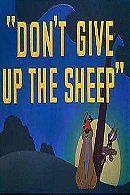
 26
26
 7.3
7.3
 8.1
8.1

